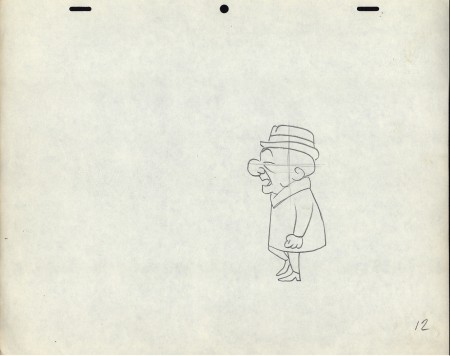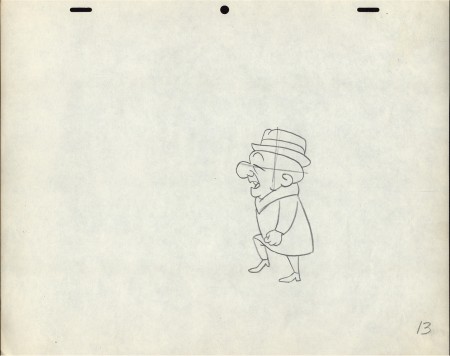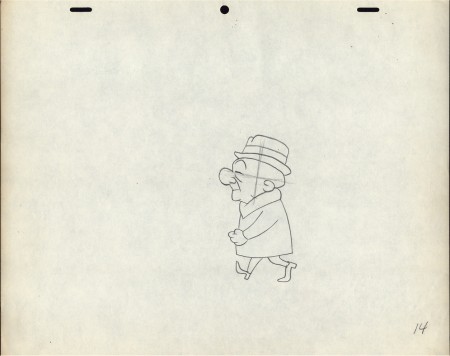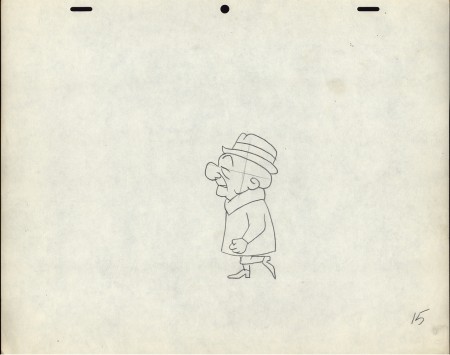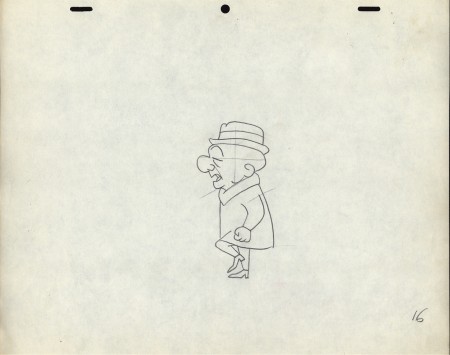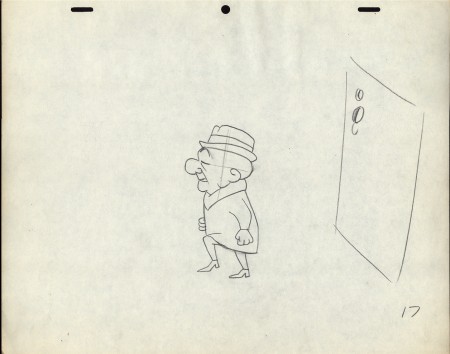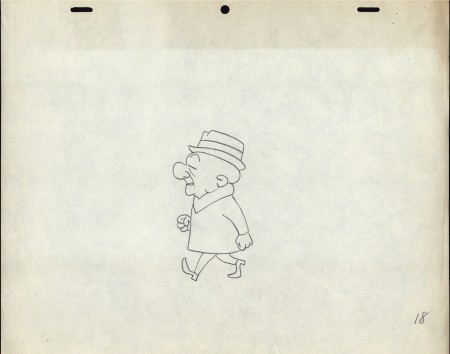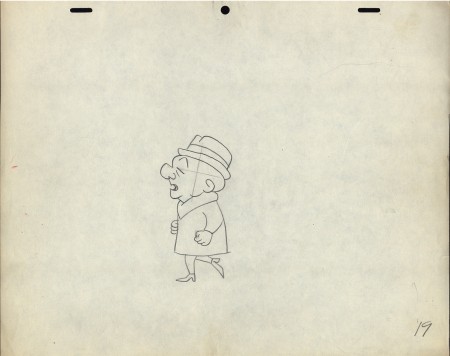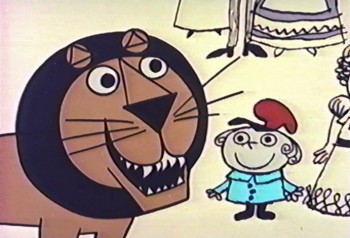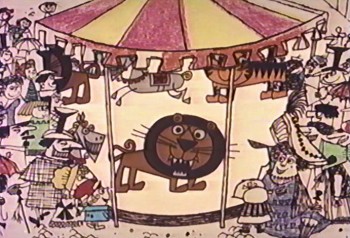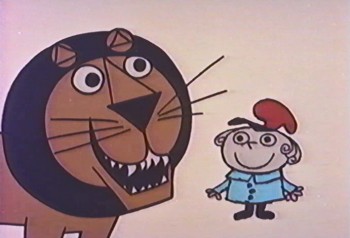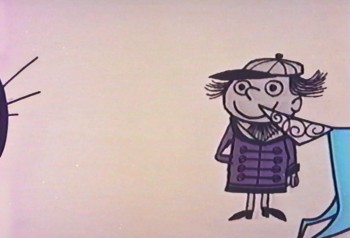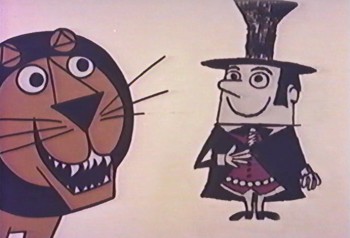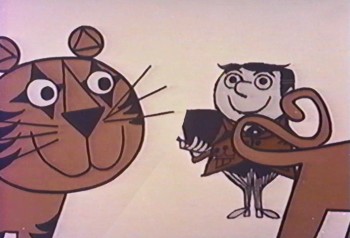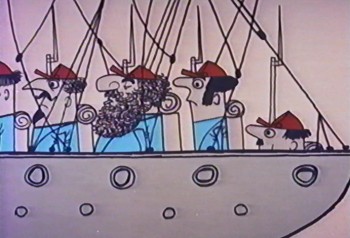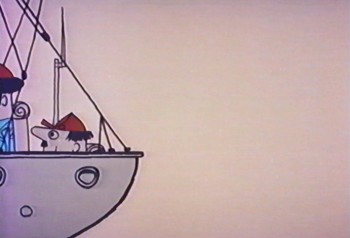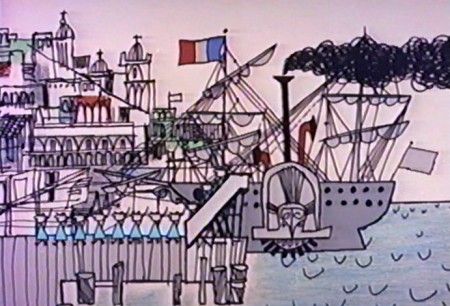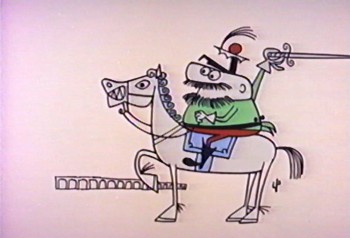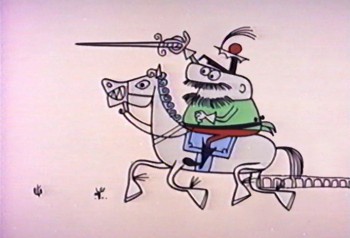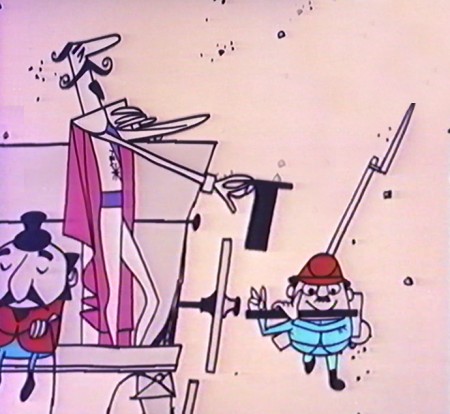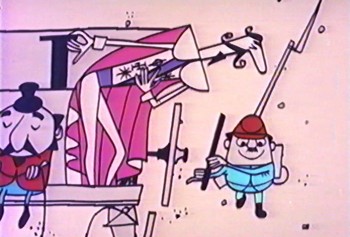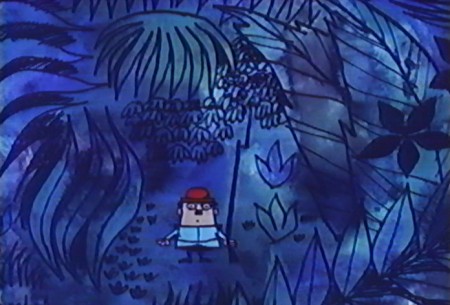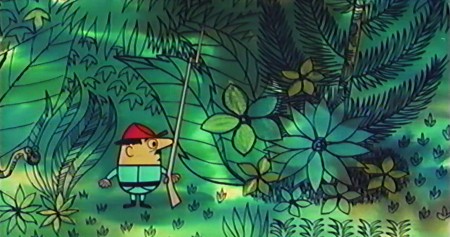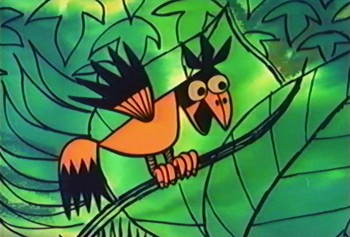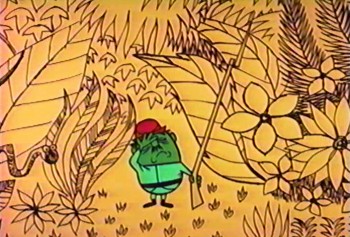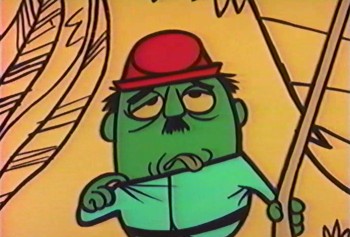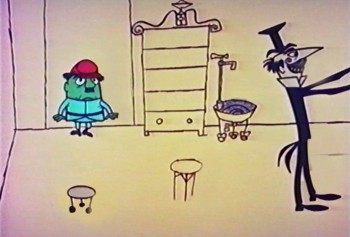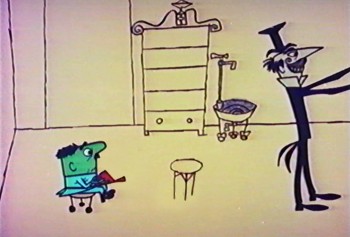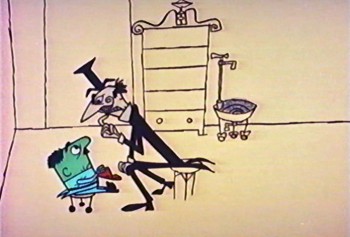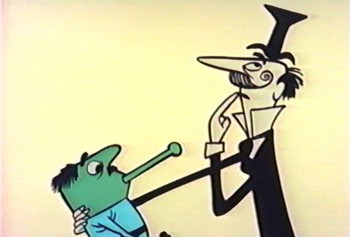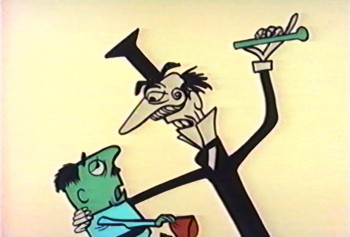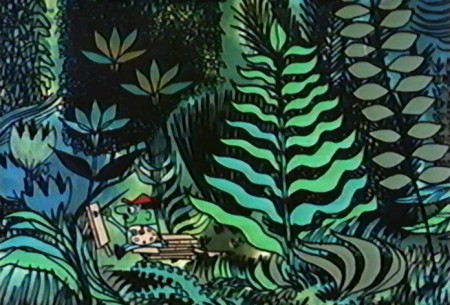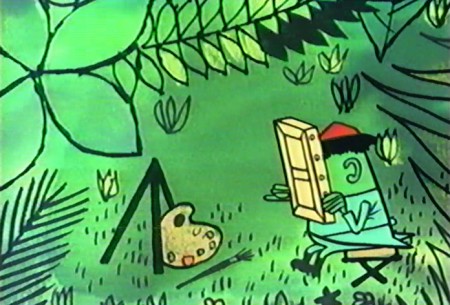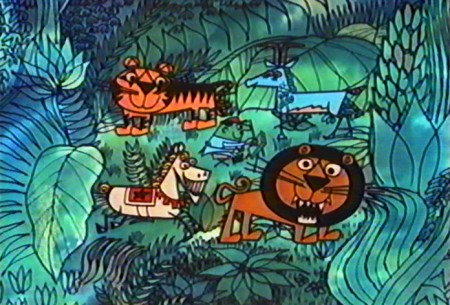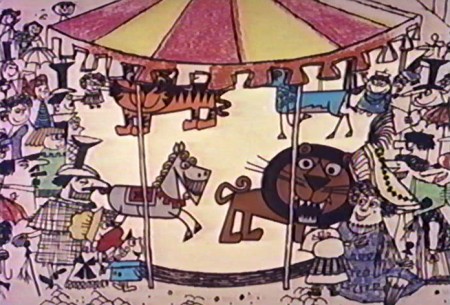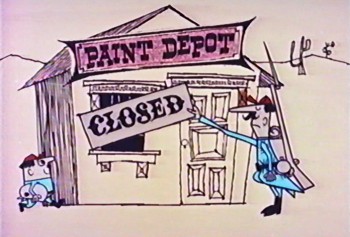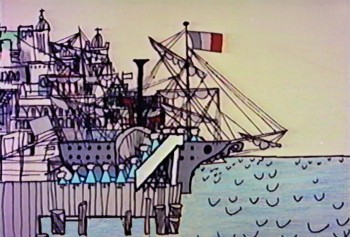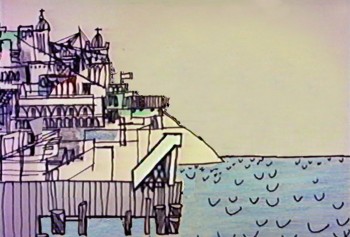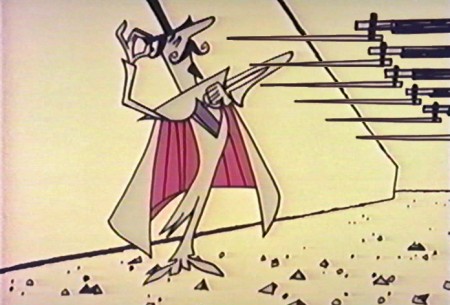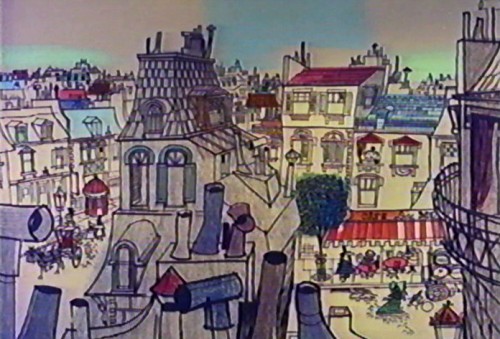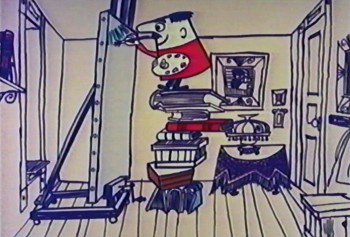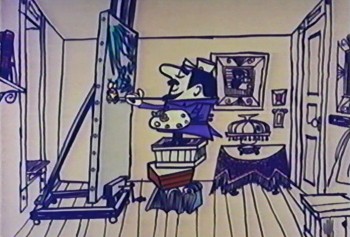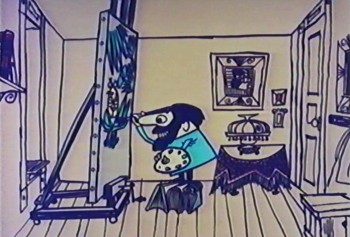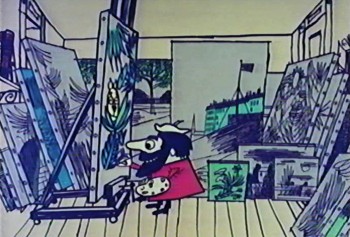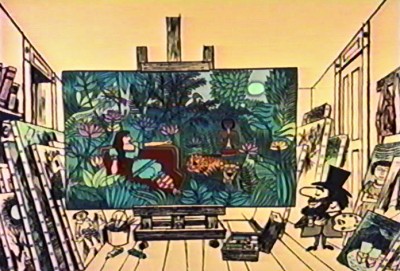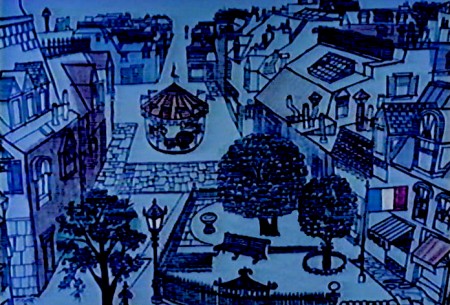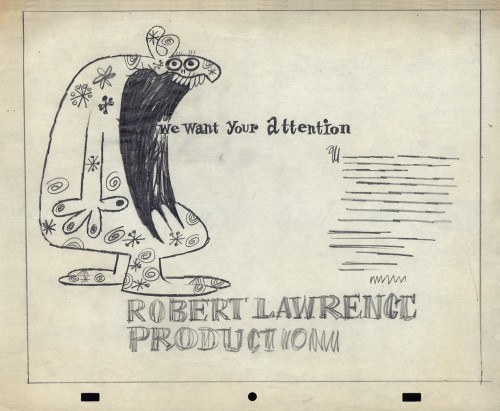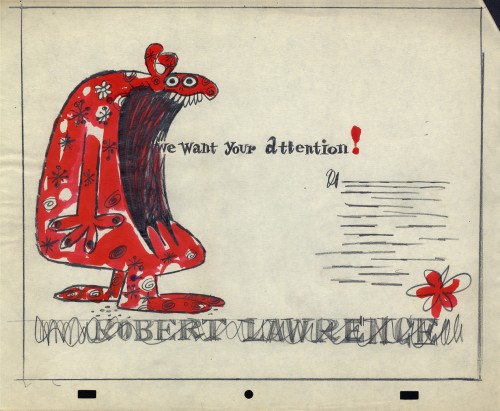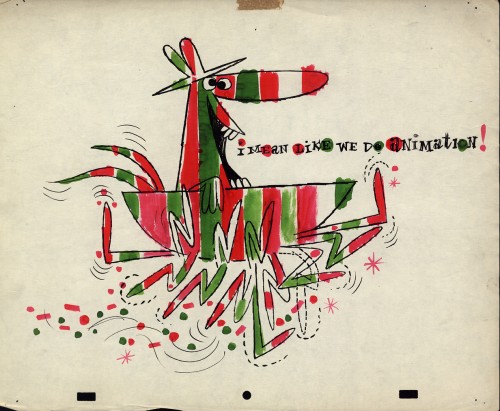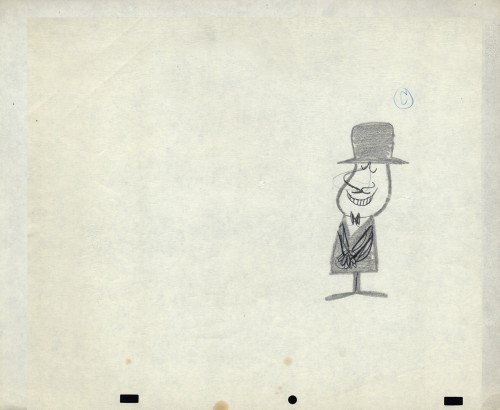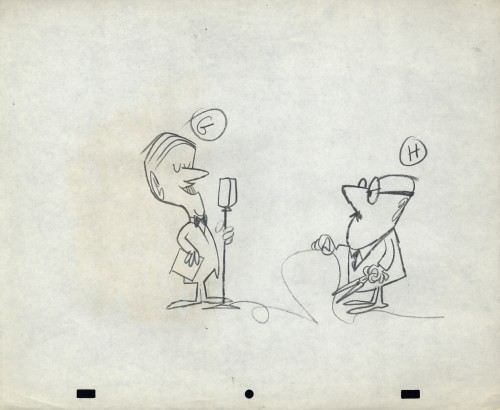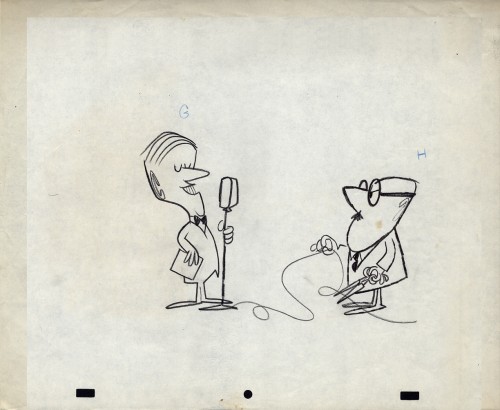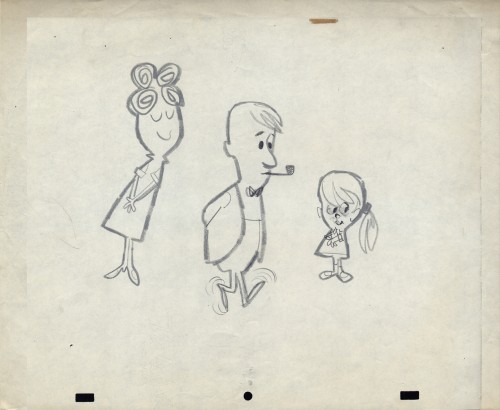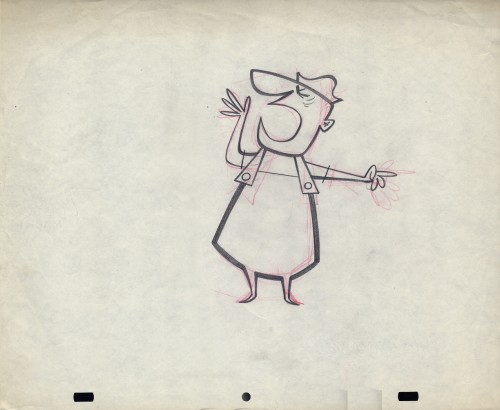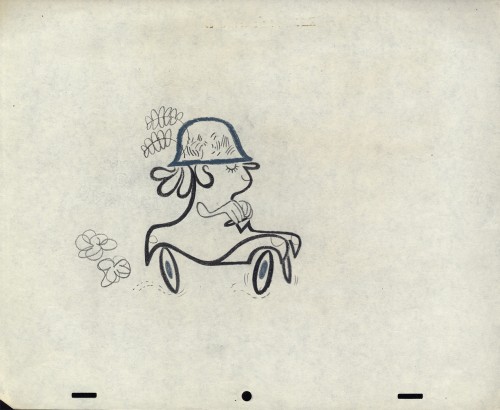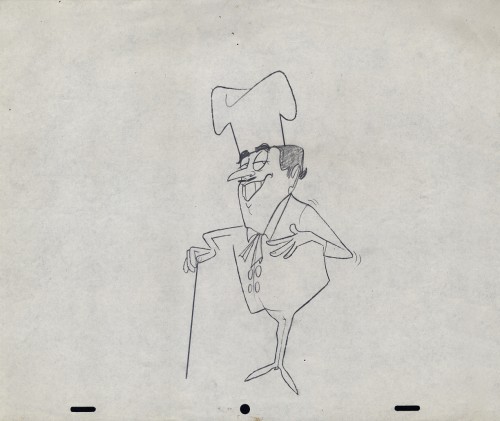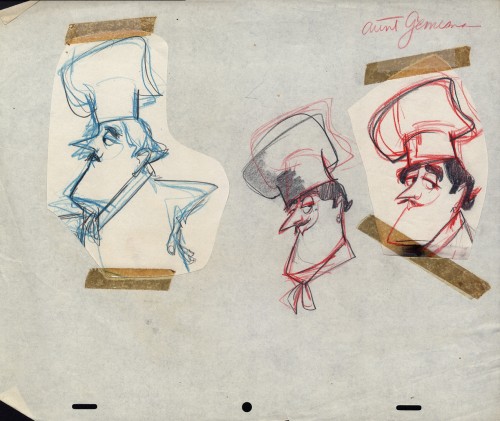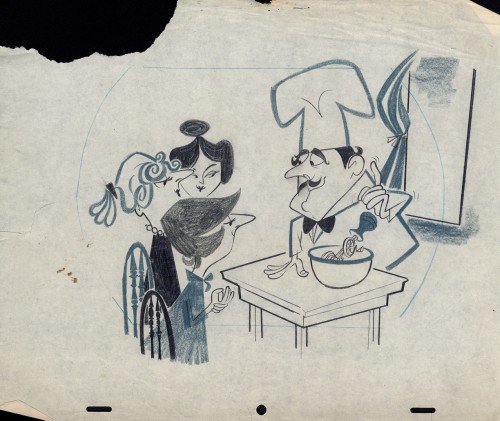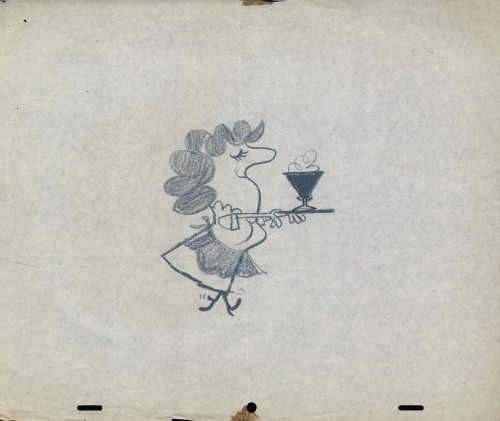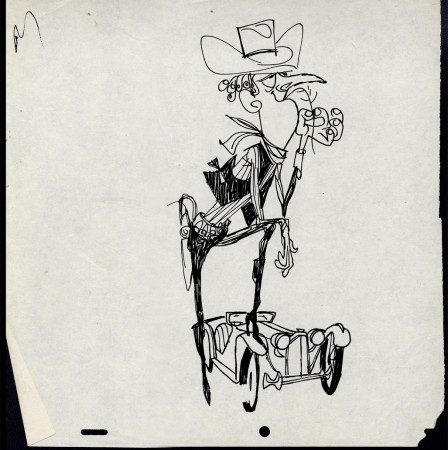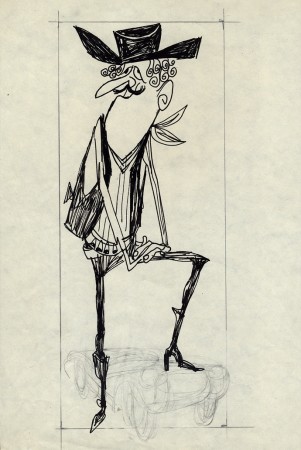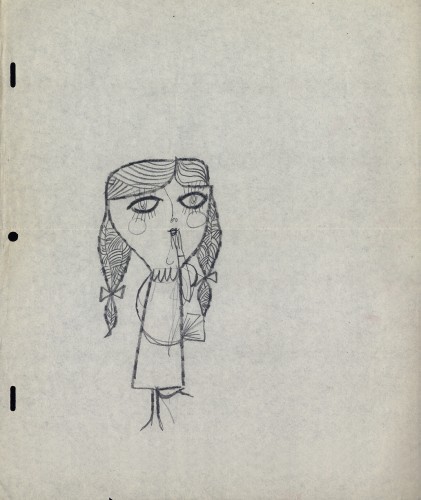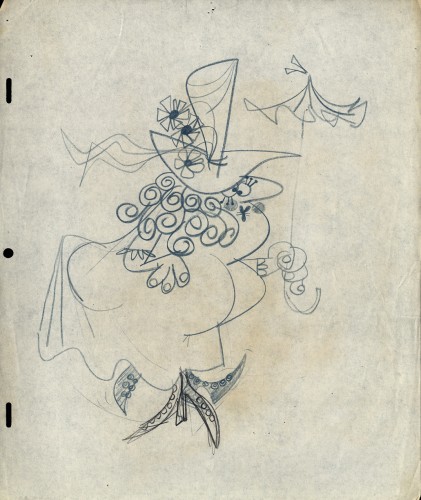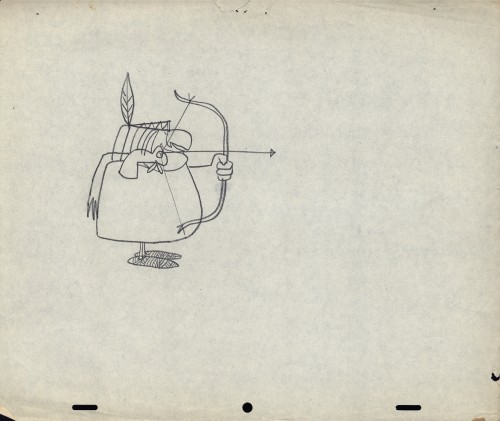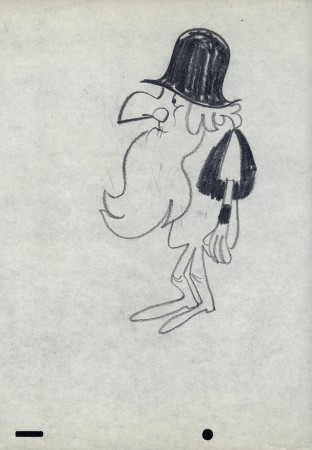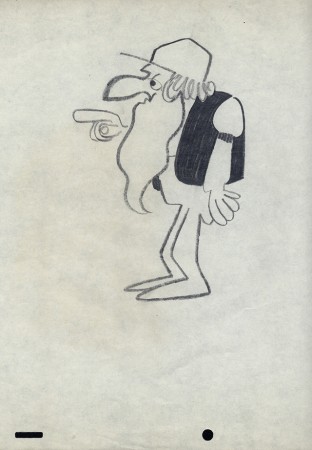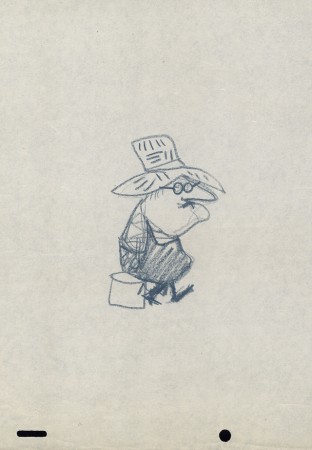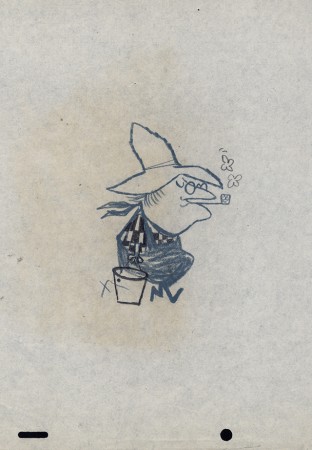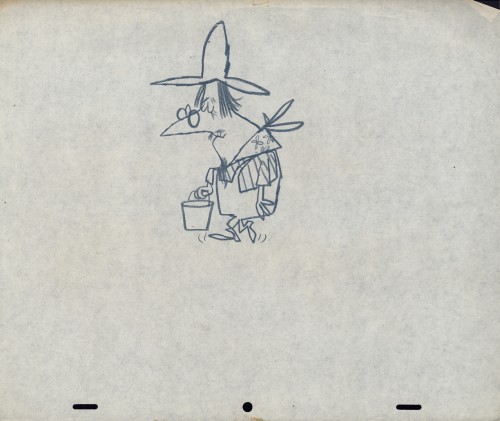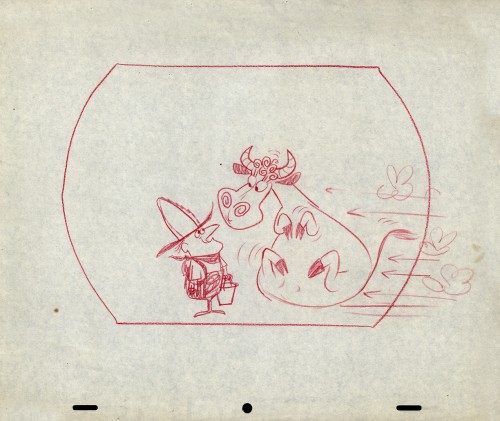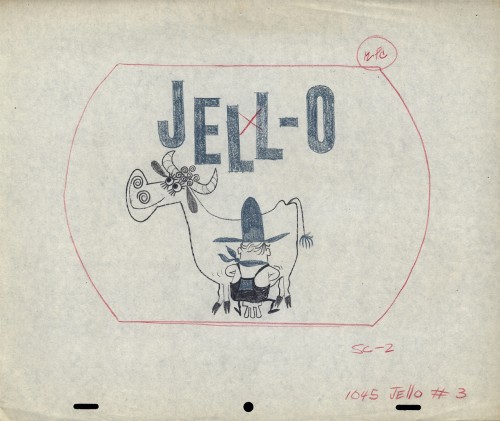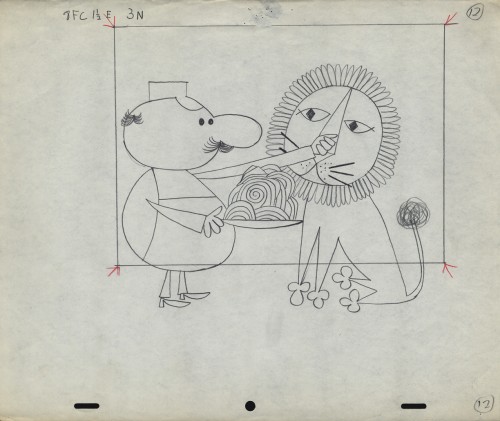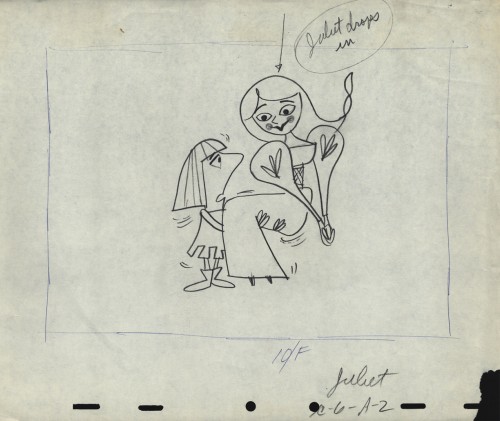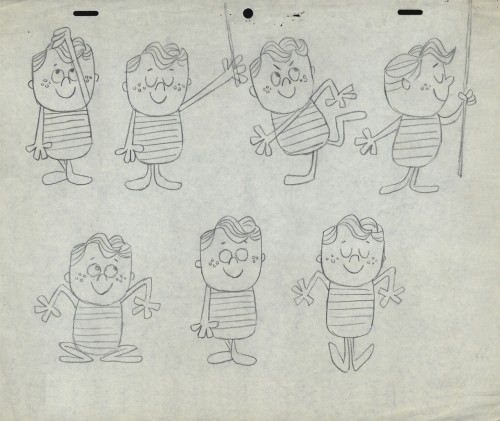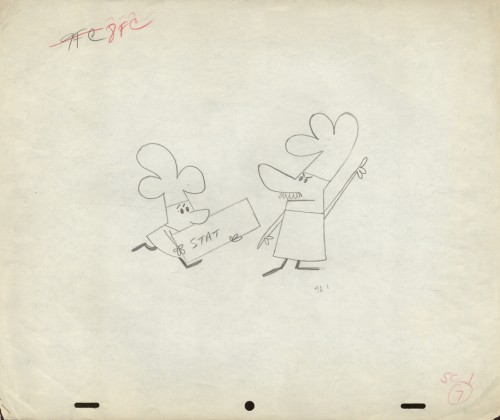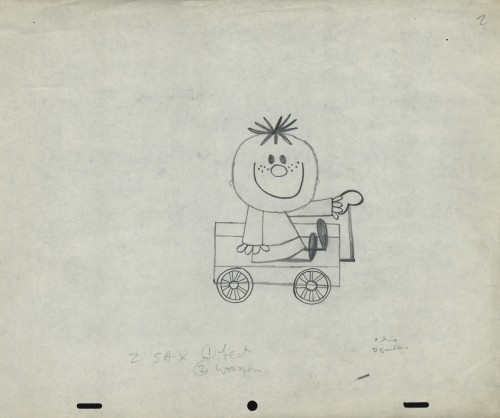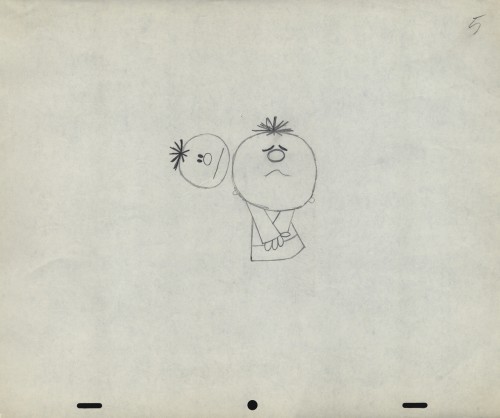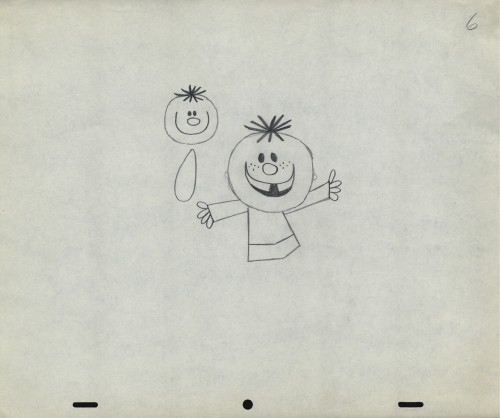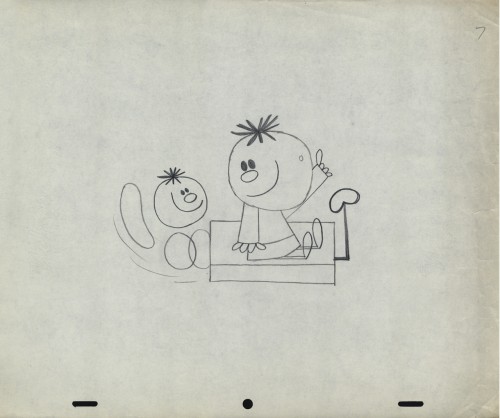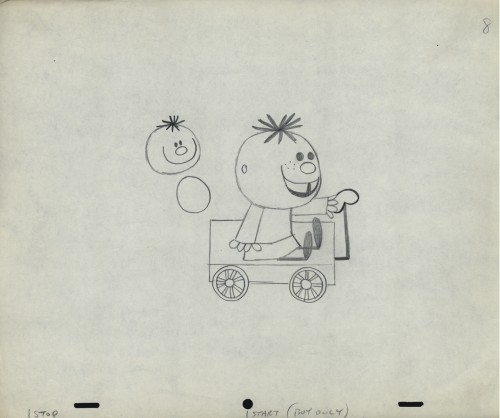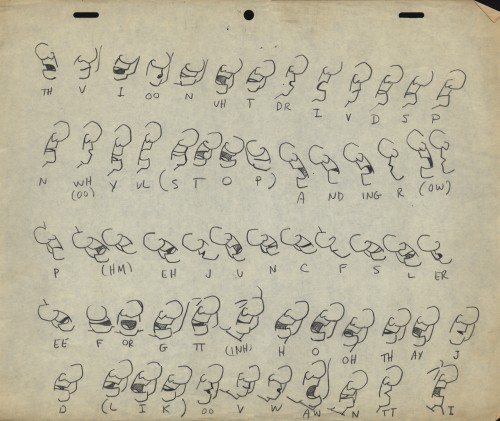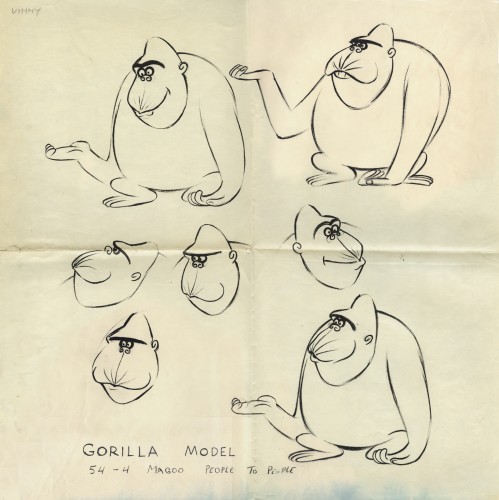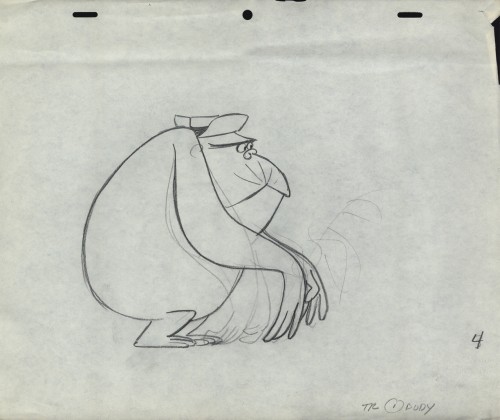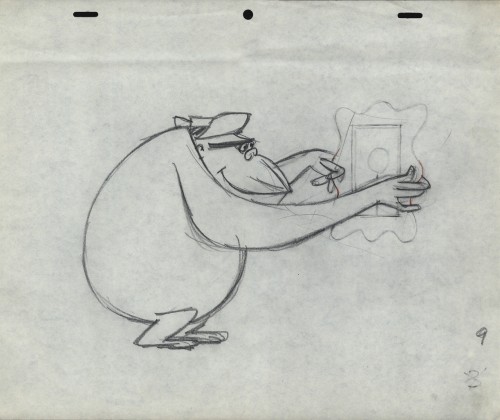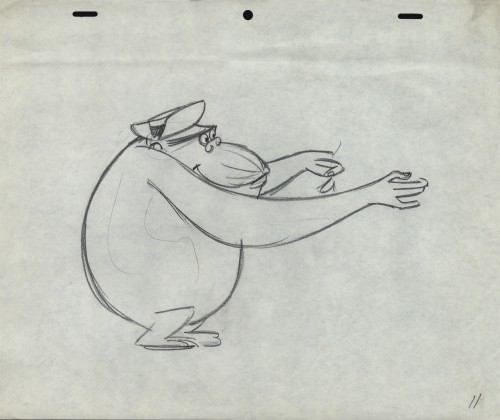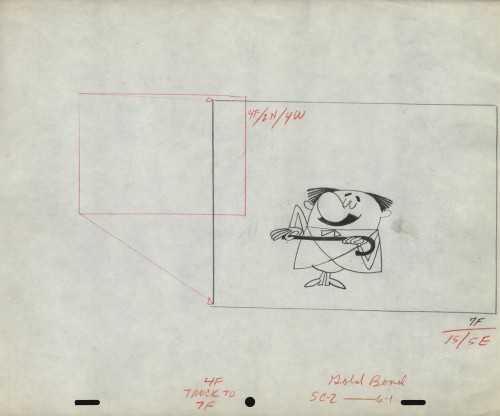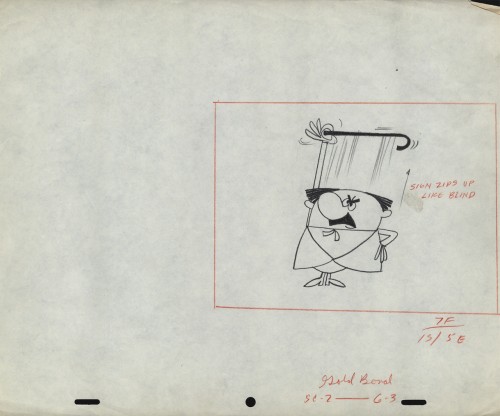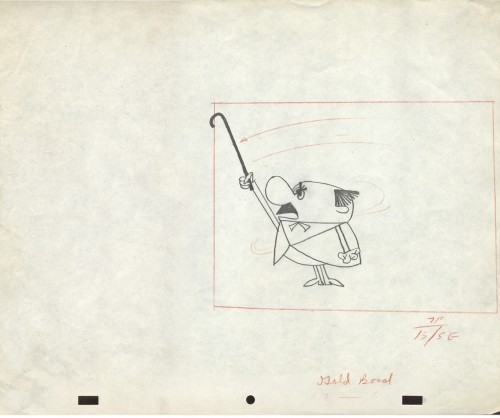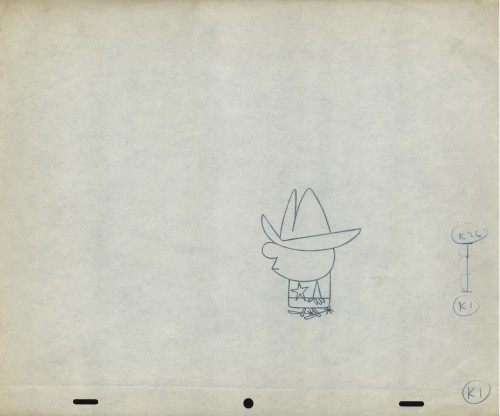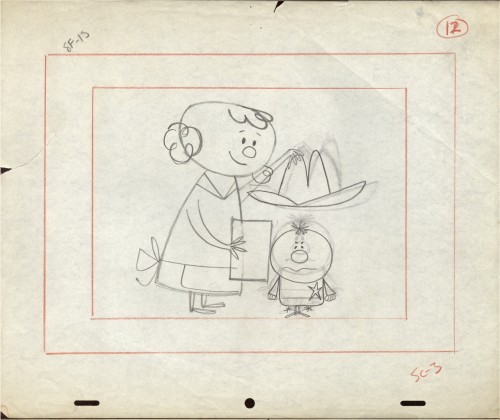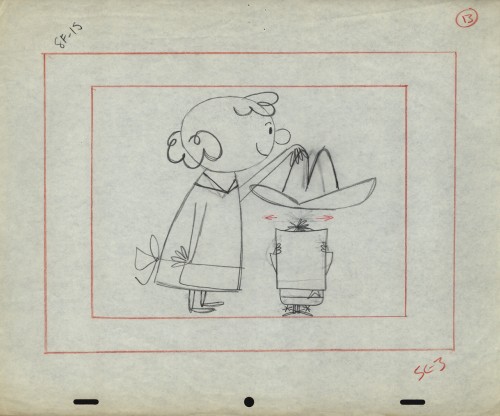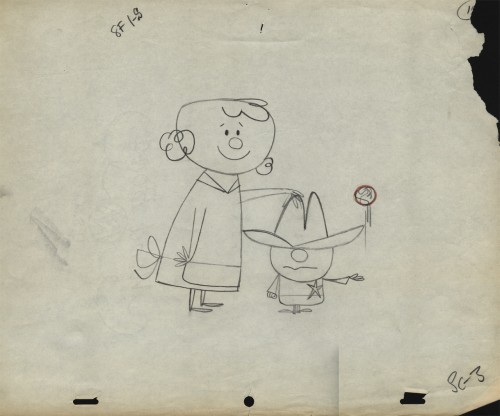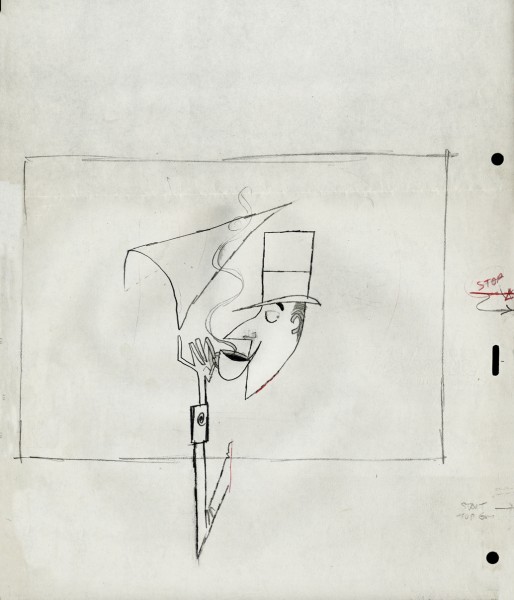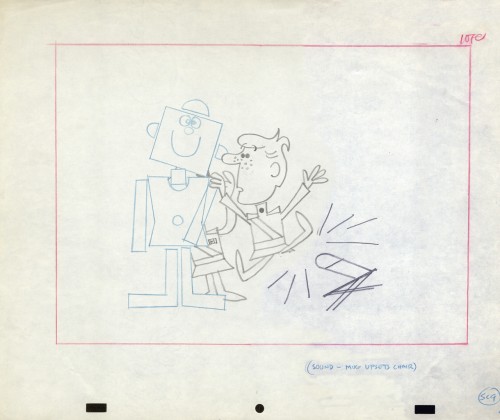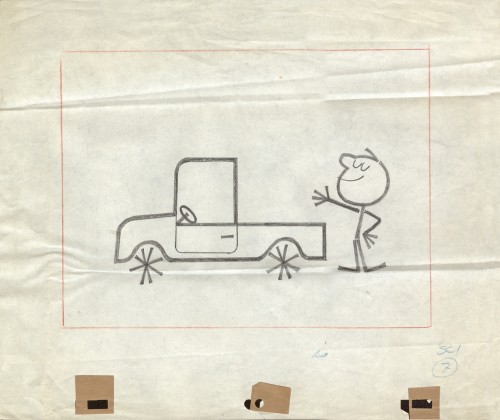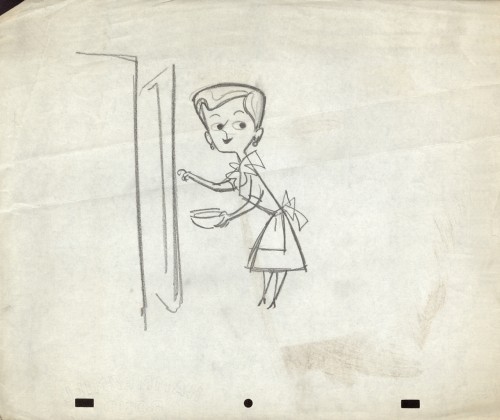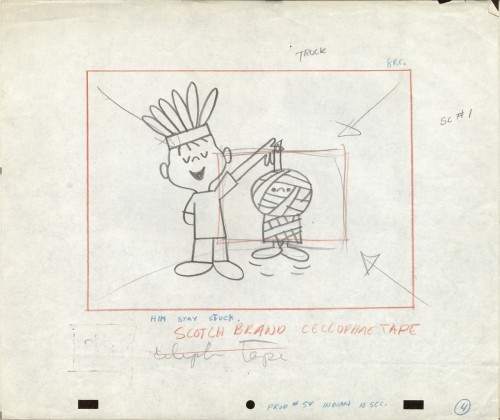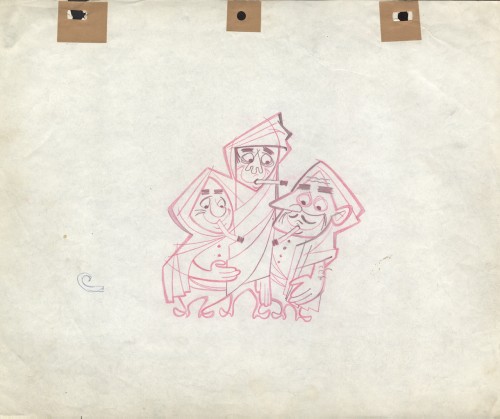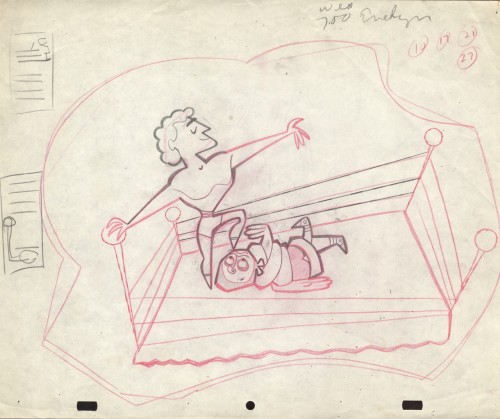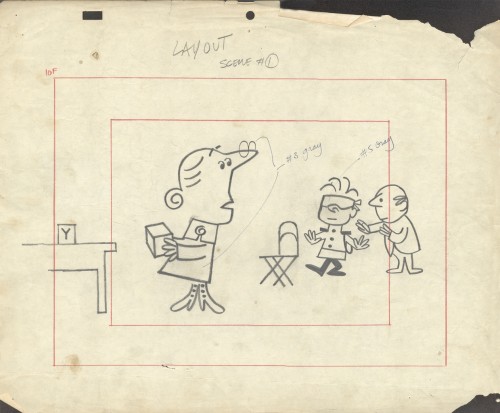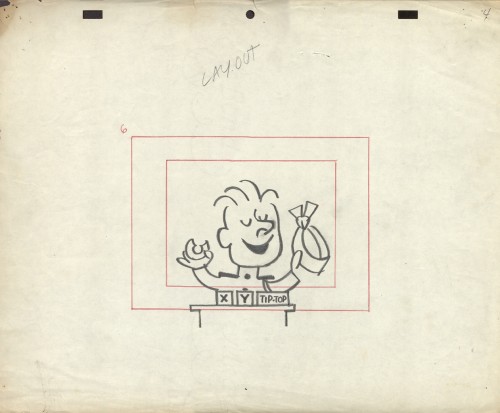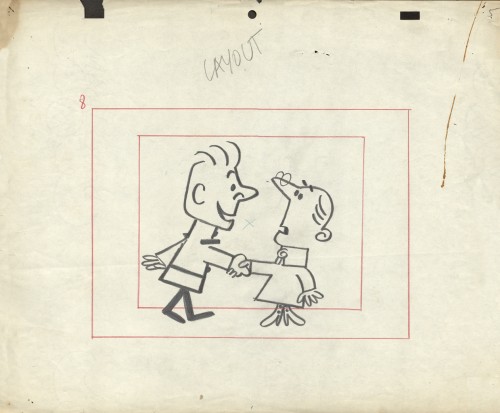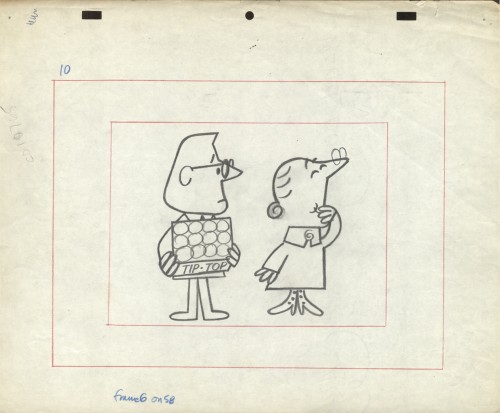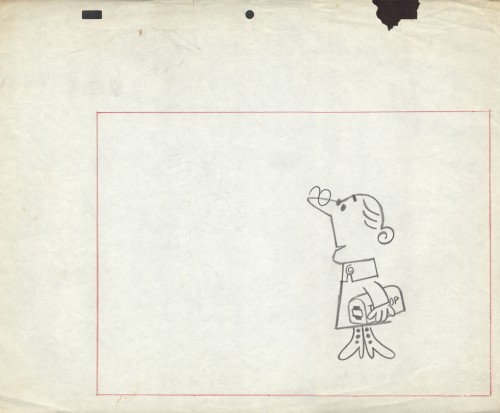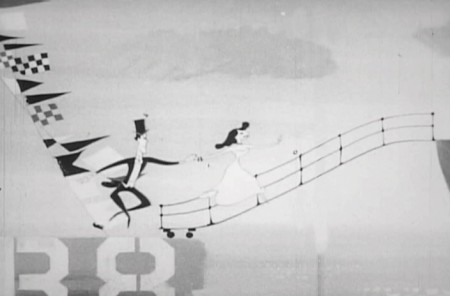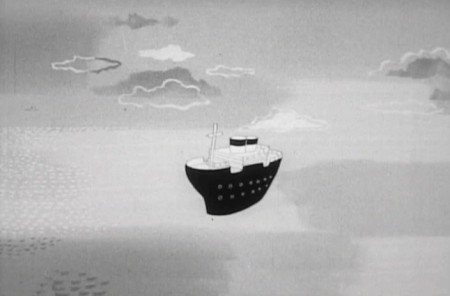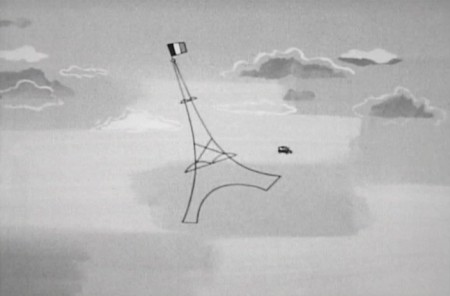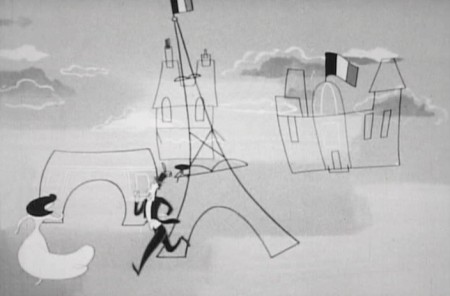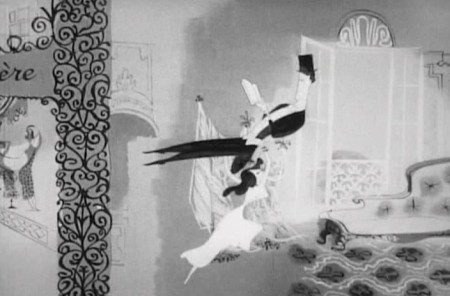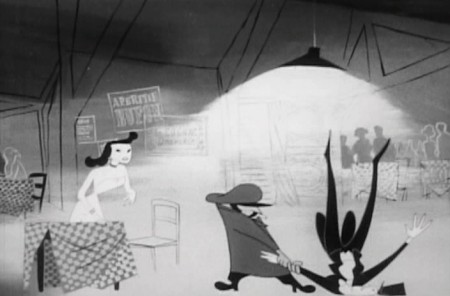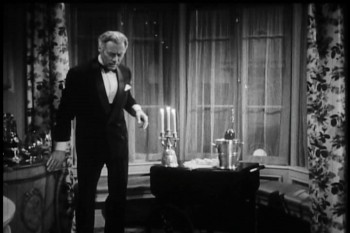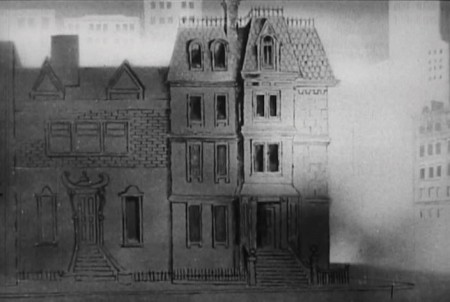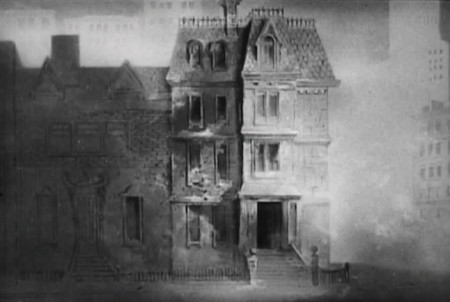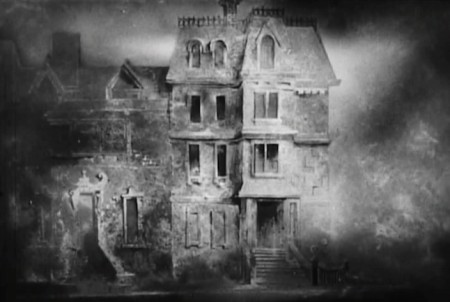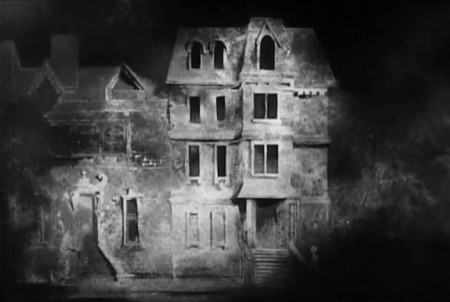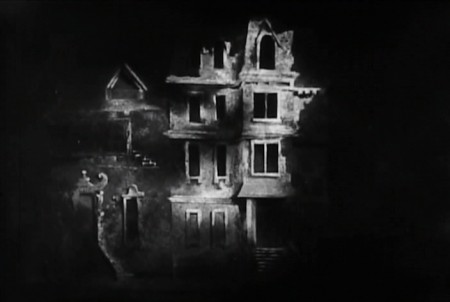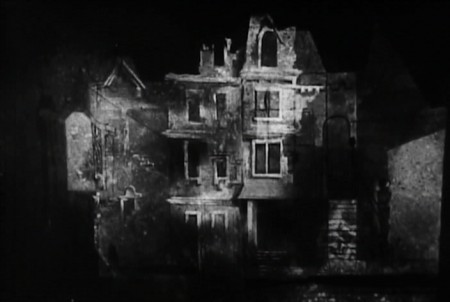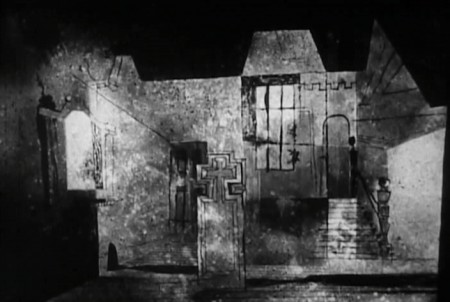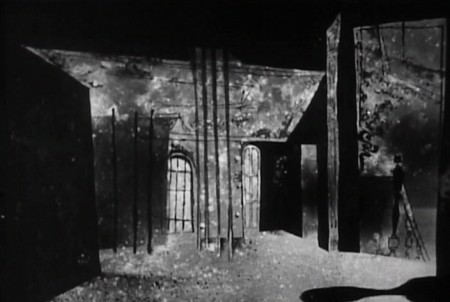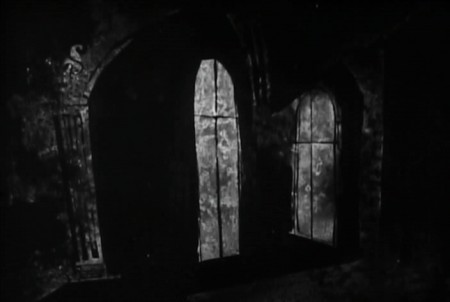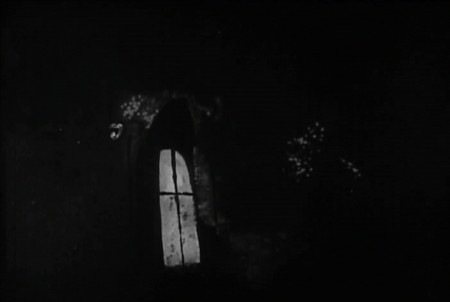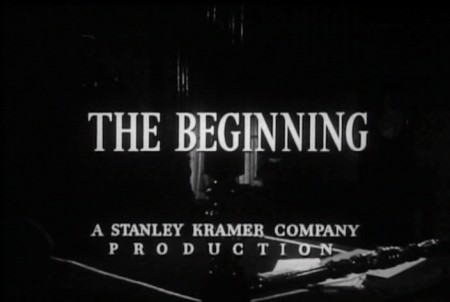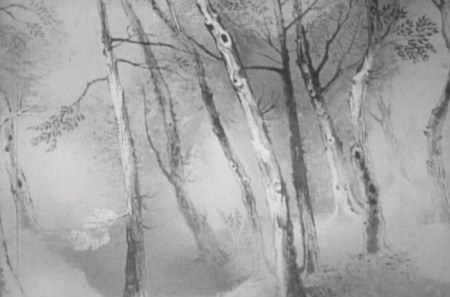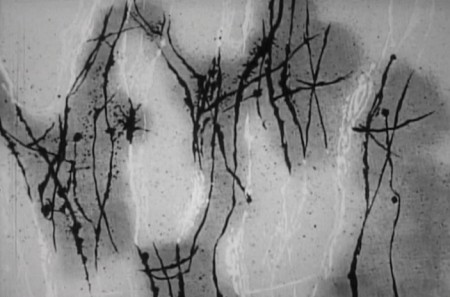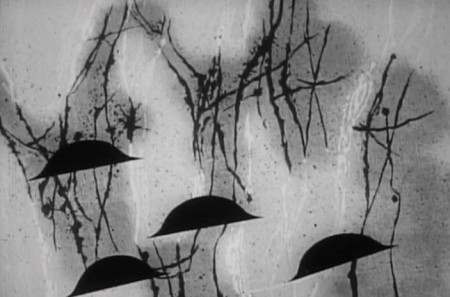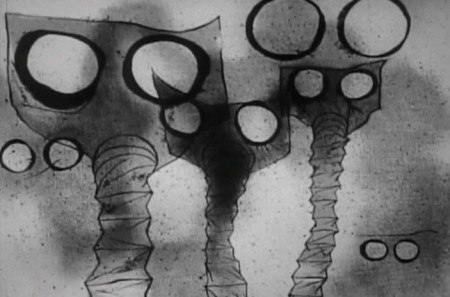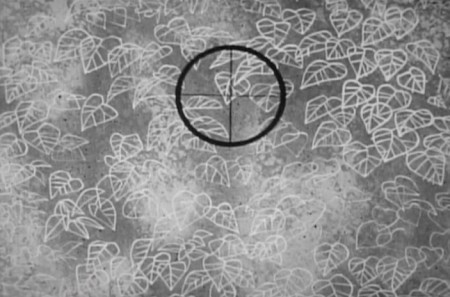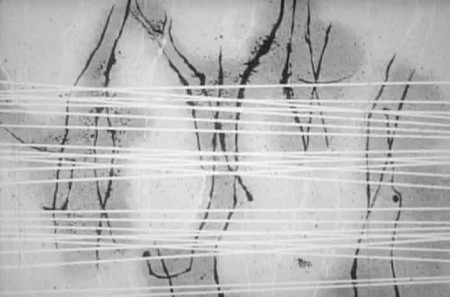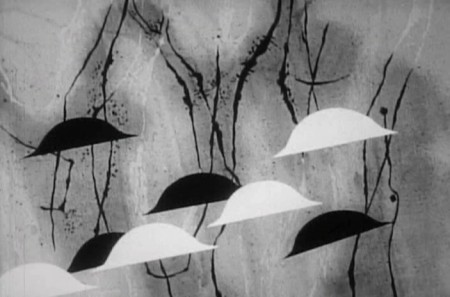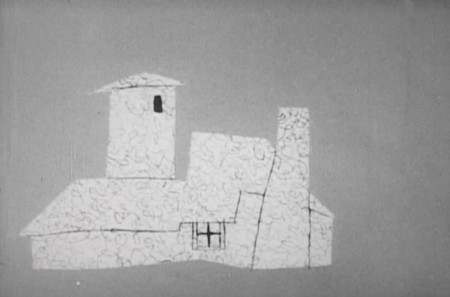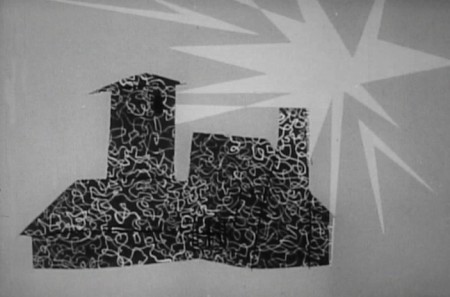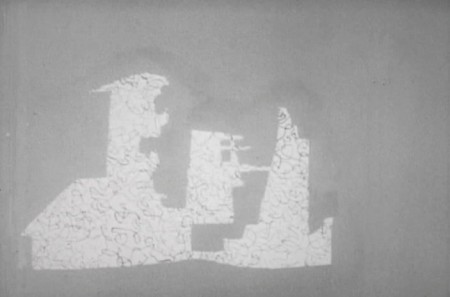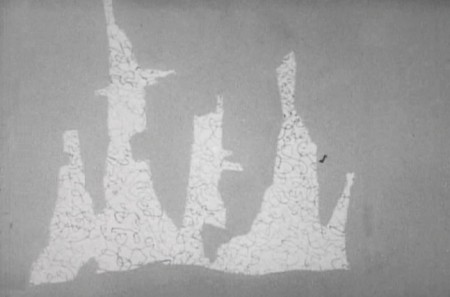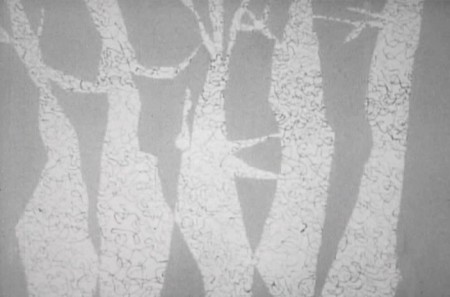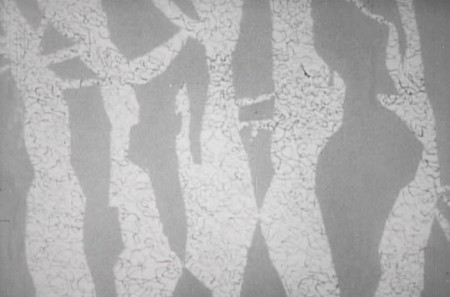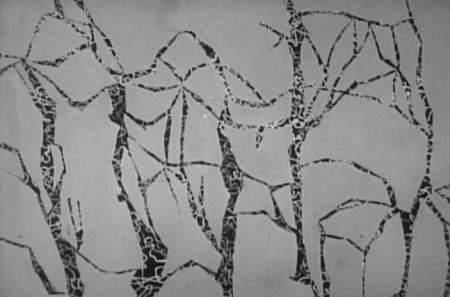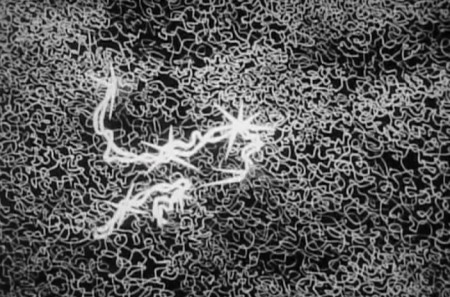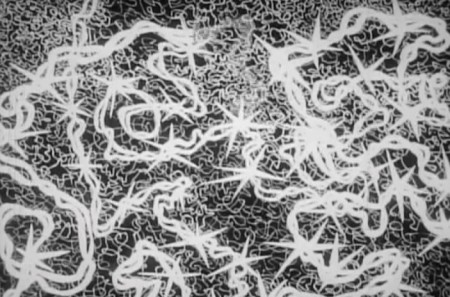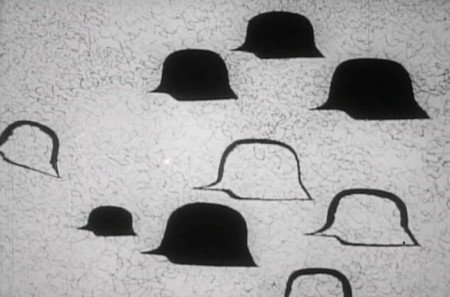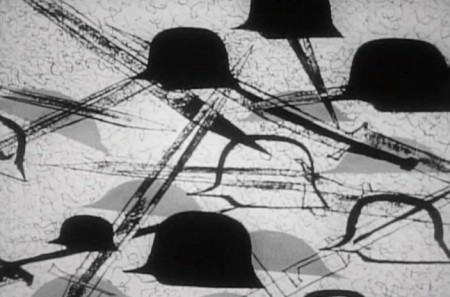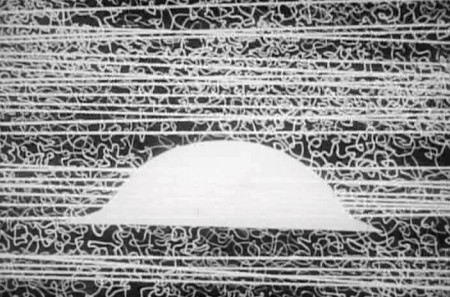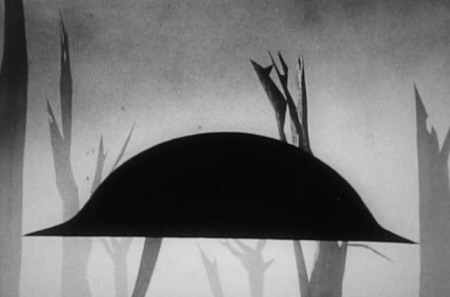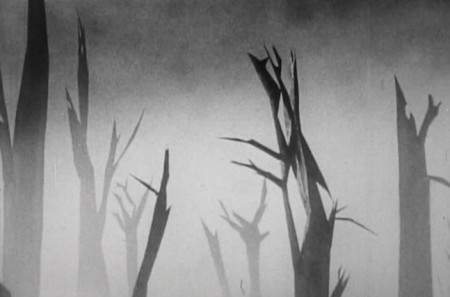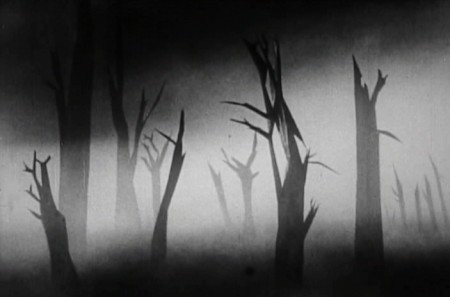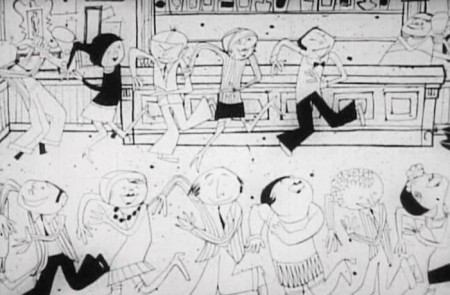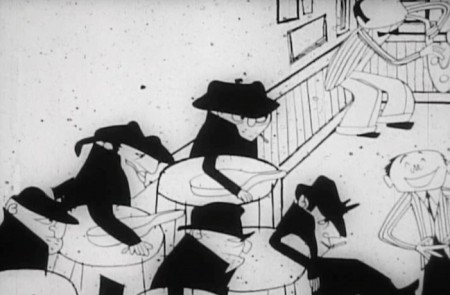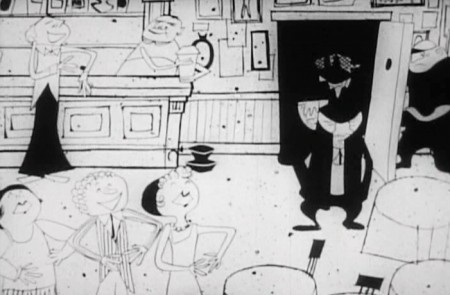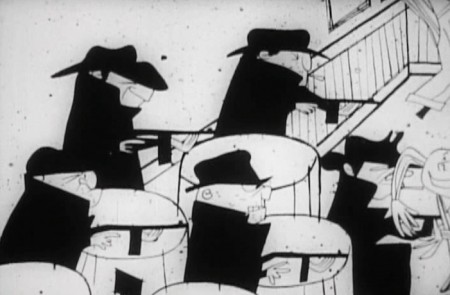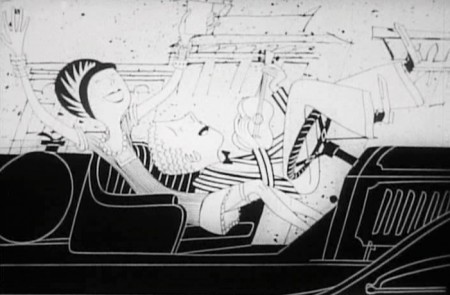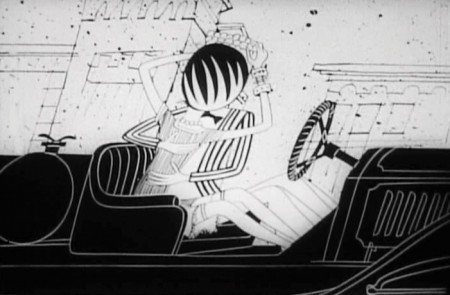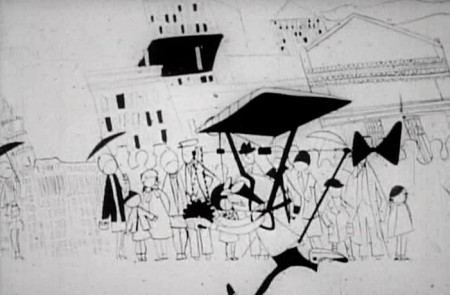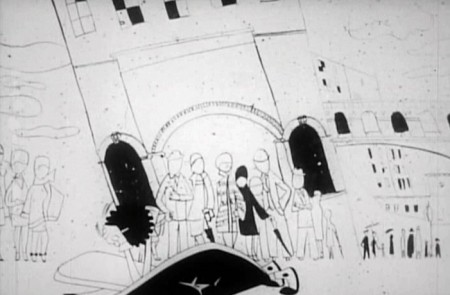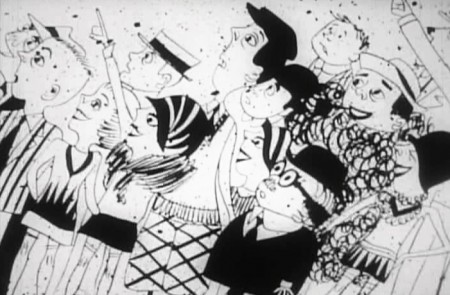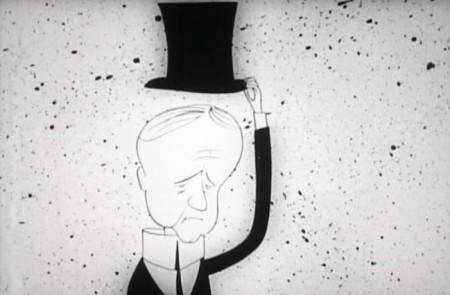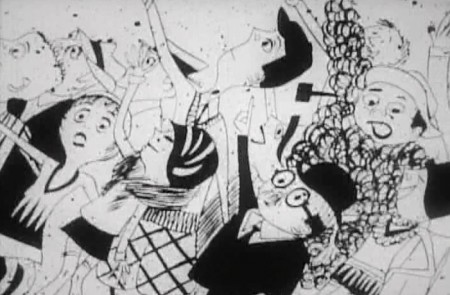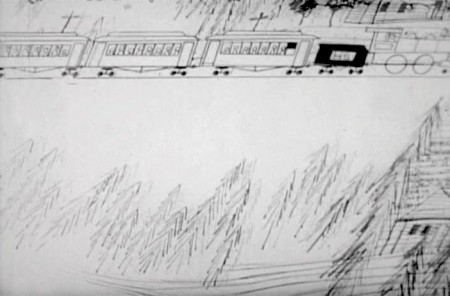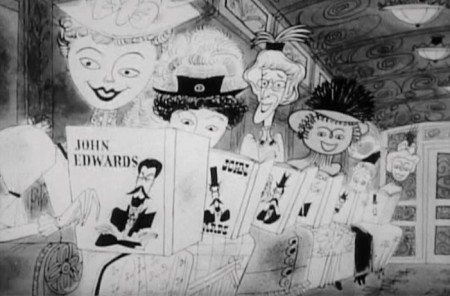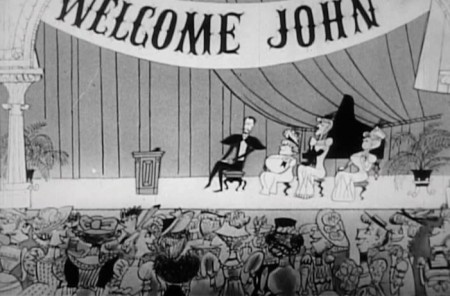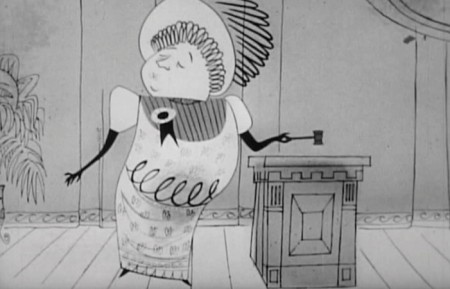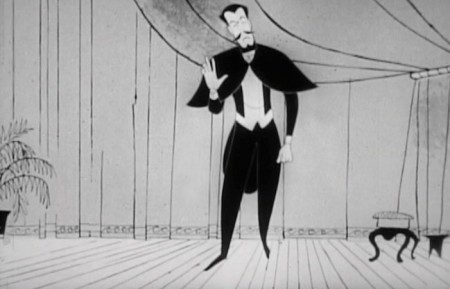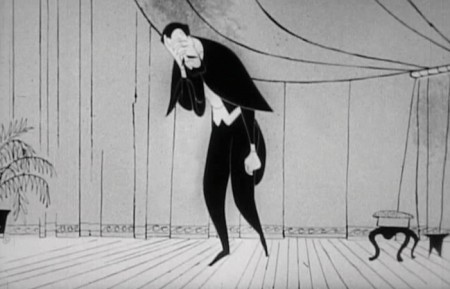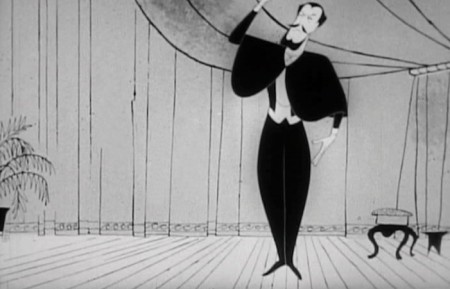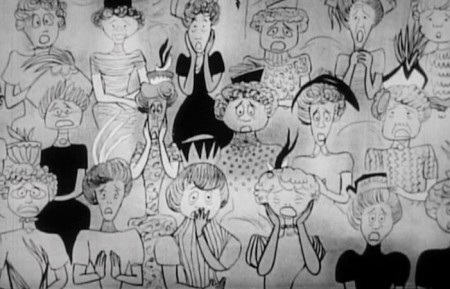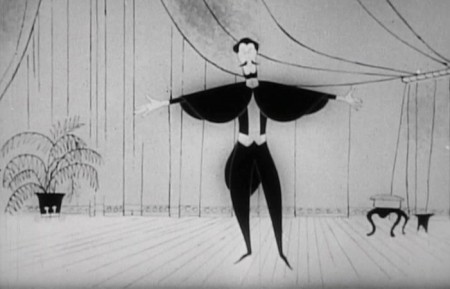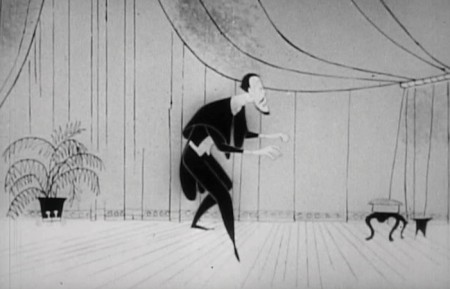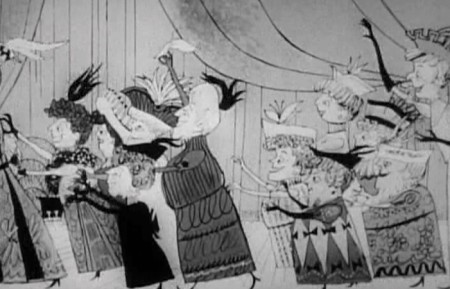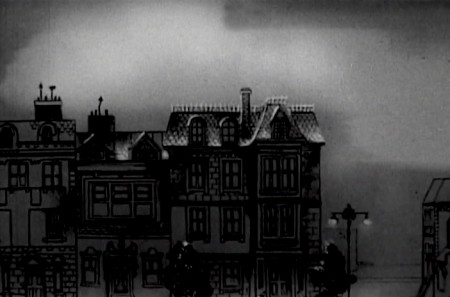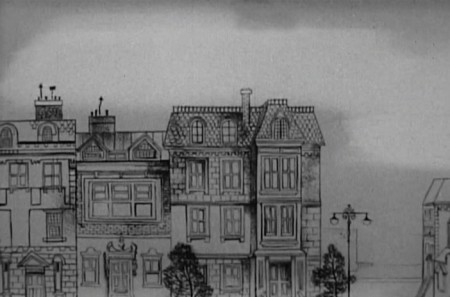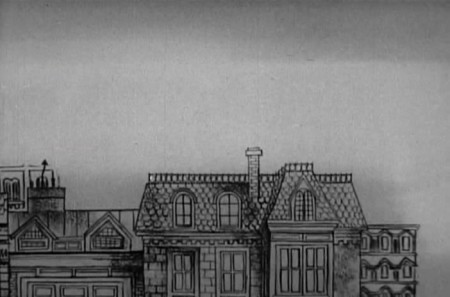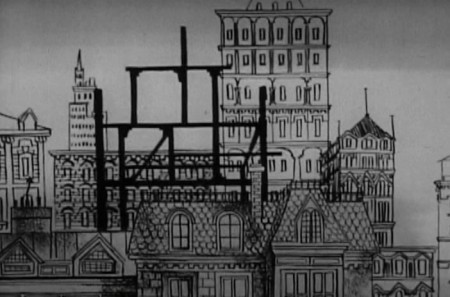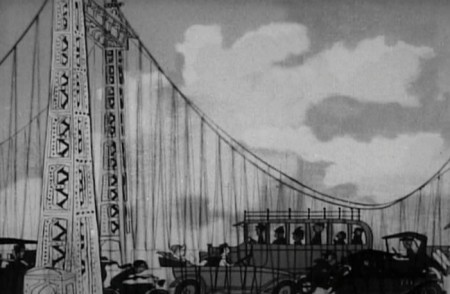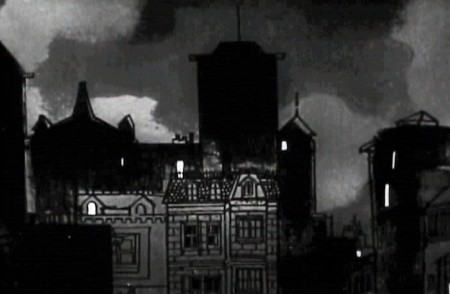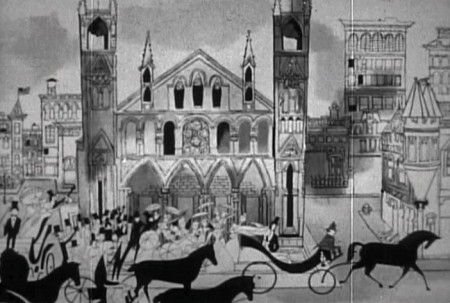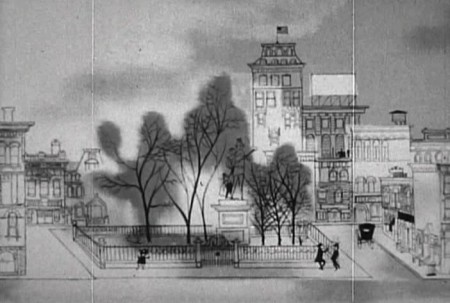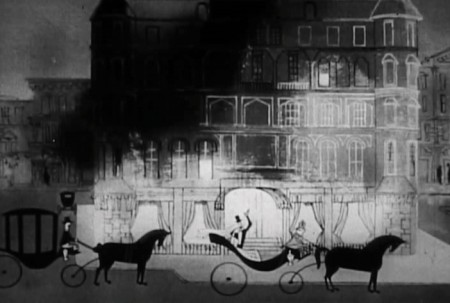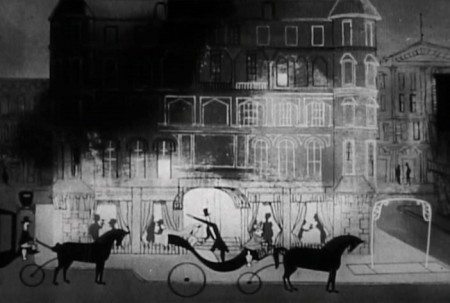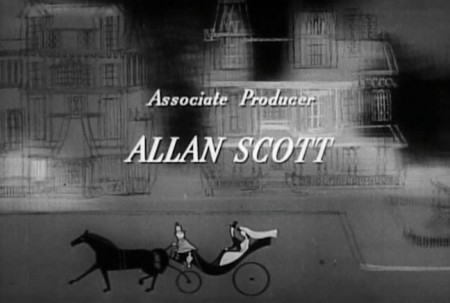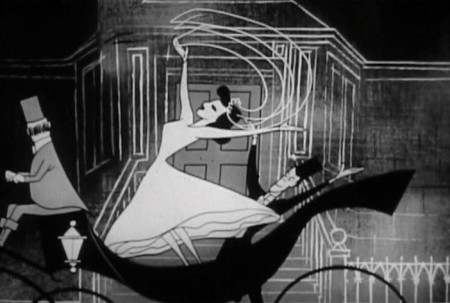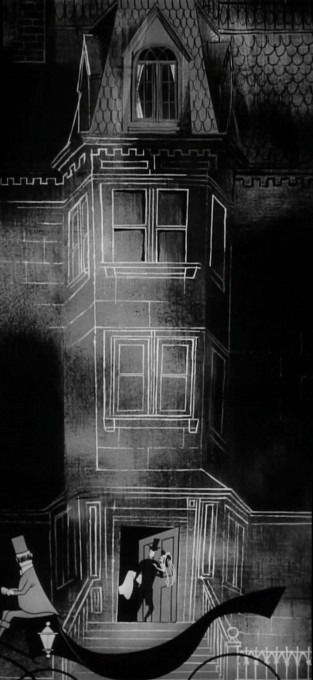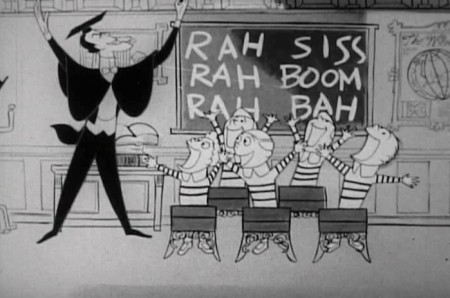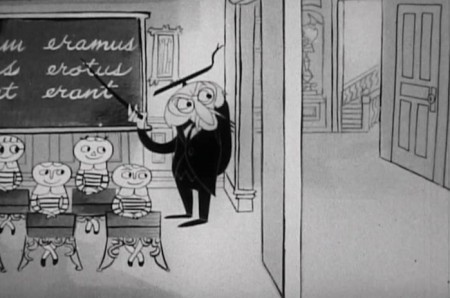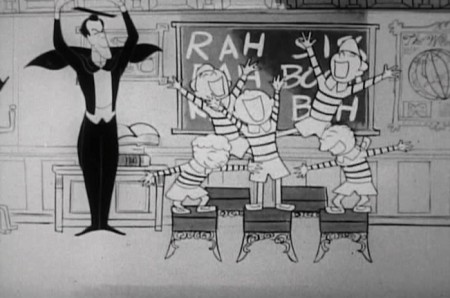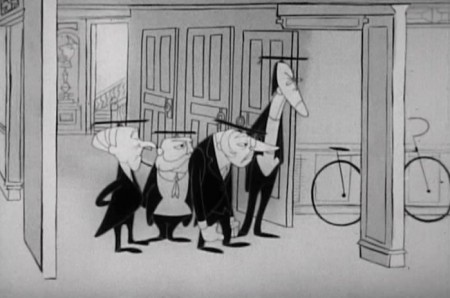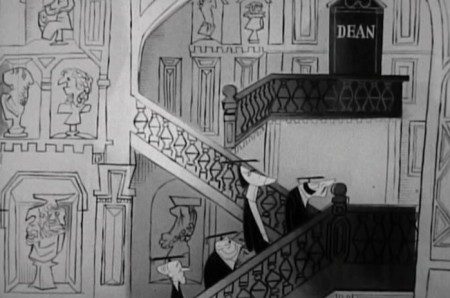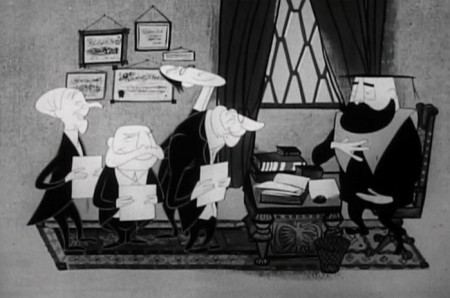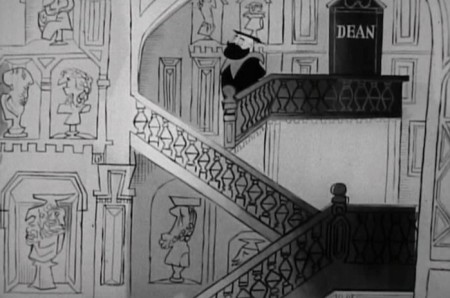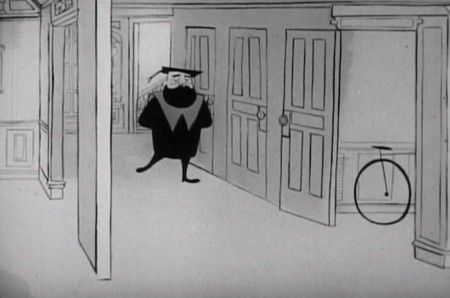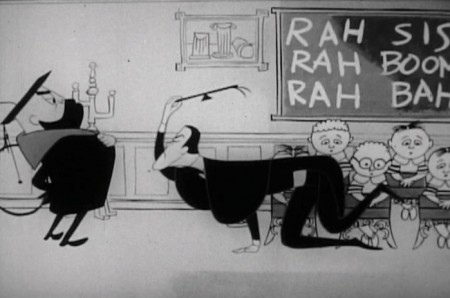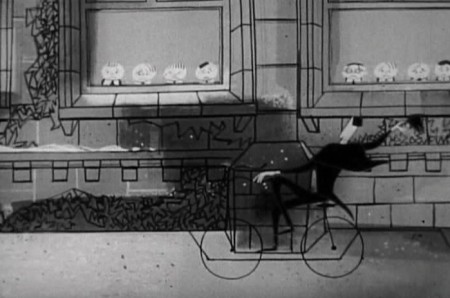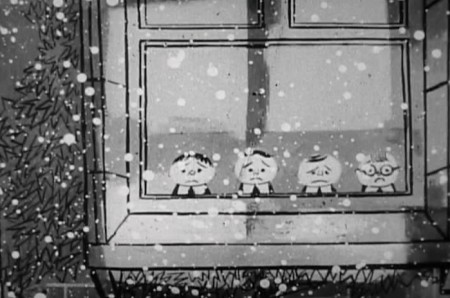Category ArchiveUPA
Animation &commercial animation &UPA &walk cycle 29 Nov 2012 08:08 am
Magoo Walk Cycle
- There’s no way to know who animated this walk cycle. Perhaps it’s a commercial by Lu Guarnier. Vince Cafarelli was Lu’s assistant; so if I had to guess, I’d say that Lu animated it and Vince did the cleanup.
For the QT movie of it, I moved the character into place so that we could run it on a cycle.
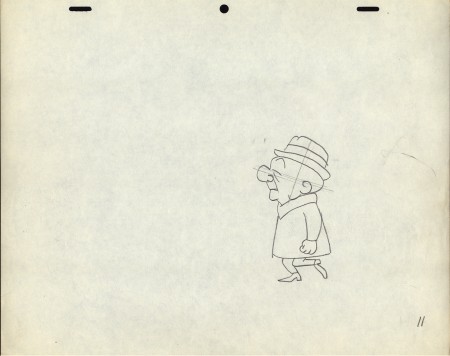 11
____________________
11
____________________The following QT movie was made reworking the positioning
of the character on the pages. This enables us to see a repeated
cycle without Magoo bouncing back to the starting position.
It’s certainly a fast walk.
You figure a natural walk is 12 frames per foot hit / 24 frames for both.
This cycle takes just 18 frames. Presumably it’s part of the overall timing.
Frame Grabs &UPA 26 Nov 2012 05:48 am
Rousseau’s Carousel
- The Gerald McBoing Boing Show, in the 1950′s had a number of animated pieces on poets, painters and other artists. Of these the most famous film is probably The Invisible Moustache or Raoul Dufy. Another interesting film is one on the Post-Impressionist artist, Henri Rousseau.
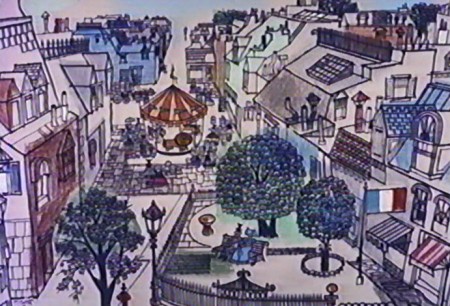 1
1
The film is obviously a fiction, and a most peculiar one at that.
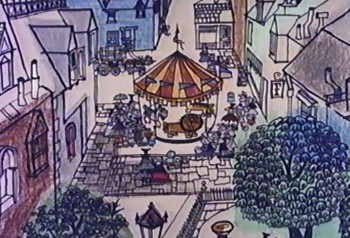 2
2
In the film’s story, Rousseau was in love with . . .
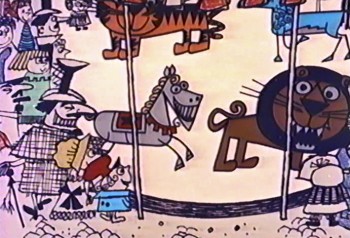 3
3
. . . the wild animals to ride on a local Carousel.
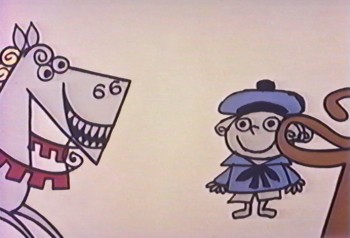 7
7
As he grew older, those wild creatures . . .
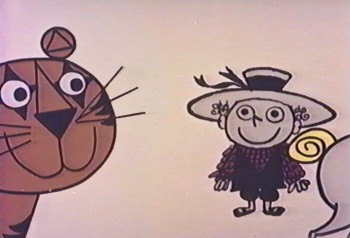 8
8
. . . which he used to ride as a child, remained . . .
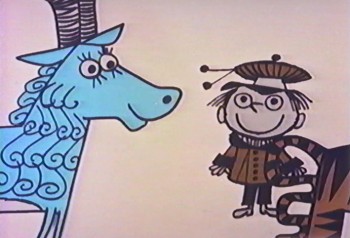 9
9
. . . repressed in his consciousness.
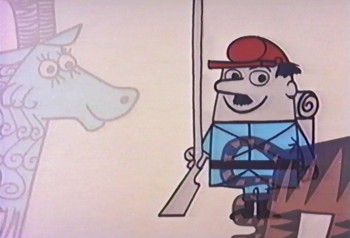 13
13
Once he goes into the military, he worked closely . . .
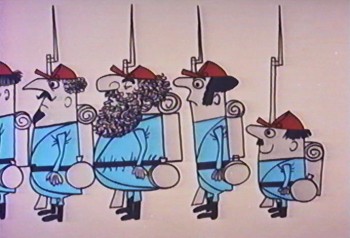 14
14
. . . with the Emperor Maximilian.
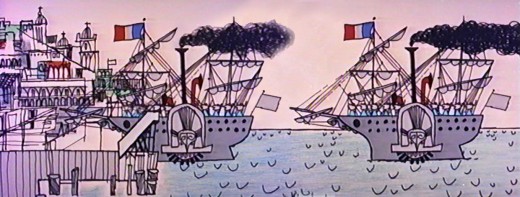
The ship pulls into the harbor . . .

The troops move right to left through the frame leading the Emperor forward.
(Click on the image to enlarge it.)
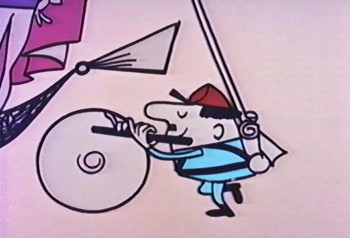 22
22
The tardy Rousseau walks behind the Emperor’s carriage . . .
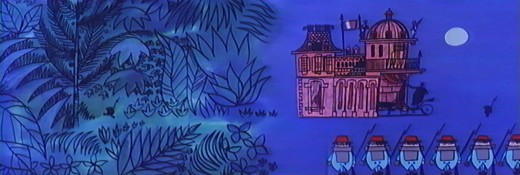
The Emperor’s carriage pulls into the palace,
and the soldier, Rousseau, goes into the forest.
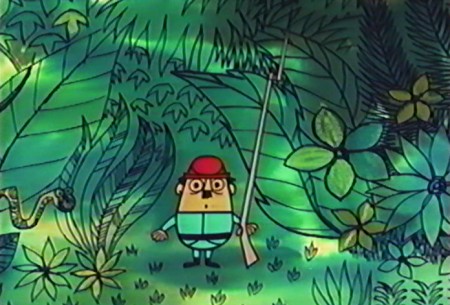 27
27
His prescription was to take up a hobby, painting.
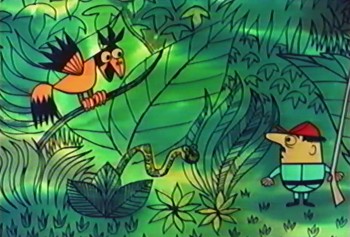 30
30
Once, on guard in the forest . . .
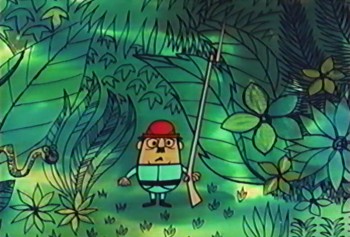 31
31
. . . Rousseau grew very ill.
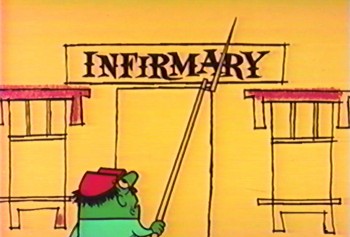 34
34
He took himself to a doctor.
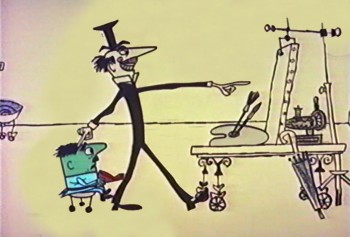 40
40
The prescription was for him to take up painting.
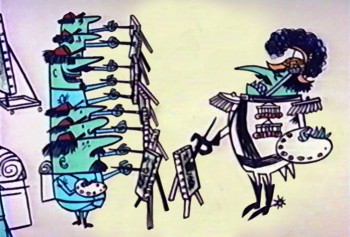 41
41
Everyone else in the military was doing it.
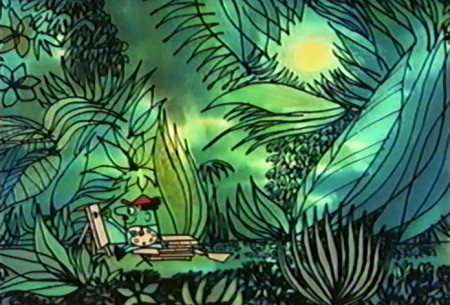 42
42
He did painting after painting . . .
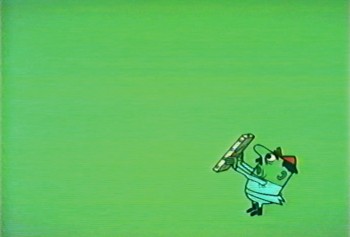 46
46
He wasn’t happy with the results.
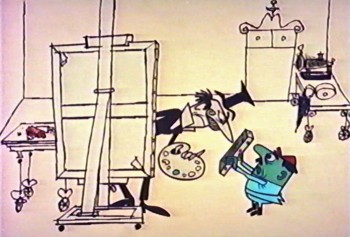 47
47
The doctor then became his number 1 critic
telling him to paint with brighter colors . . .
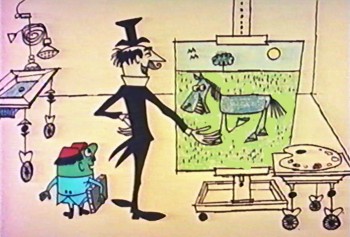 48
48
. . . and to paint the things he knew.
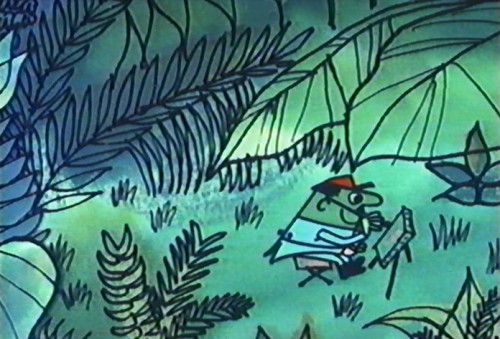 49
49
So Rousseau painted the forest and . . .
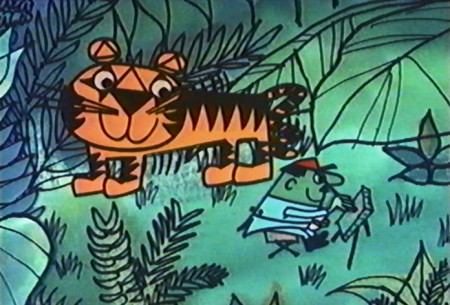 50
50
. . . began adding those carousel animals.
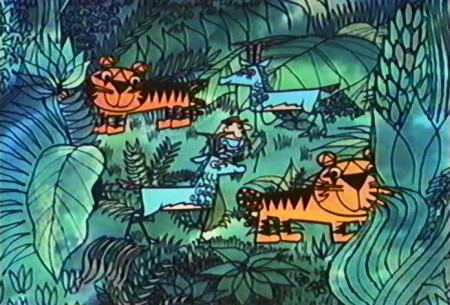 53
53
While in the military, there was a shortage of paint.
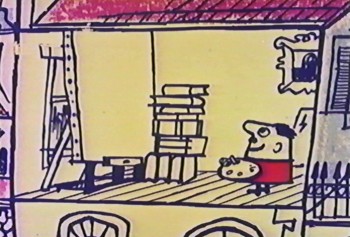 59
59
He had to wait until he was home to take up painting again.
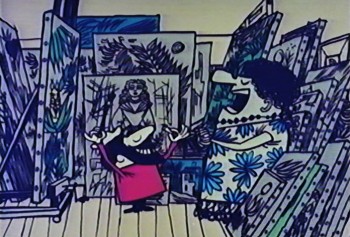 64
64
He served as a music teacher to locals, offering voice . . .
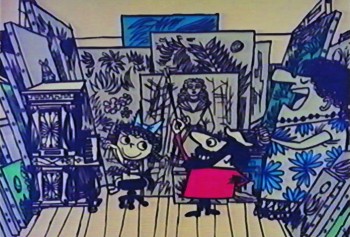 65
65
. . . piano, violin and flute lessons.
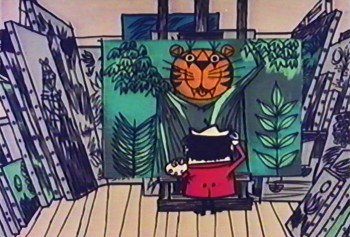 67
67
Meanwhile he painted. The paintings became famous.
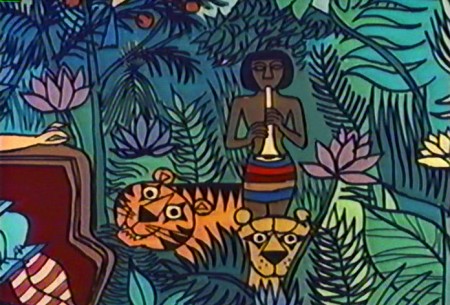 69
69
That’s not quite the true story.
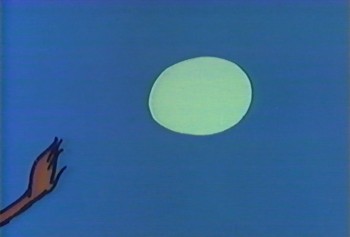 70
70
He did serve in the military under the Emperor Maximilian . . .
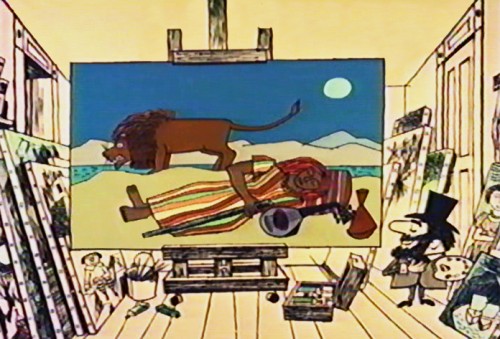 71
71
and he did work out of a lowly garret in Paris.
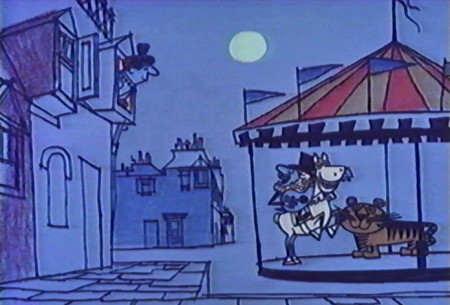 72
72
Working as a customs officer, he did his painting on the side.
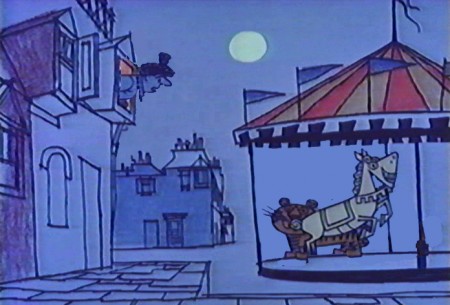 73
73
The art did achieve fame but not during Rousseau’s lifetime.
Just the same, the art is stunning as is the art from the film.
My copy of the film has no credits though no doubt Shirley Silvey
was the designer and my guess is that
Ted Parmalee was probably the director.
The video credits three animators for the three films on the video:
Fred Crippen, Frank Smith and Phil Duncan.
The animation is so limited that it might have been anyone.
I’d have guessed that Phil Duncan would have done more movement
as an older animator in the group.
Animation Artifacts &commercial animation &Layout & Design &Models &UPA 21 Nov 2012 06:56 am
Robert Lawrence Prods. – part 1
- Robert Lawrence Productions was a thriving studio in New York in the days post-UPA. Many of the animators moved from UPA, once they closed, to Robert Lawrence. Grim Natwick/Tissa David worked there (freelance), Lu Guarnier/Vince Cafarelli worked there, and consequently, Vince collected a lot of artwork from the spots he did. This post features a lot of that artwork. You’ll see how great the design and styling was at the studio, even though I don’t know what clients or sonsors they were done for. The designers certainly took off where UPA left off.
But first, let me share two in-house studio gags done at UPA.
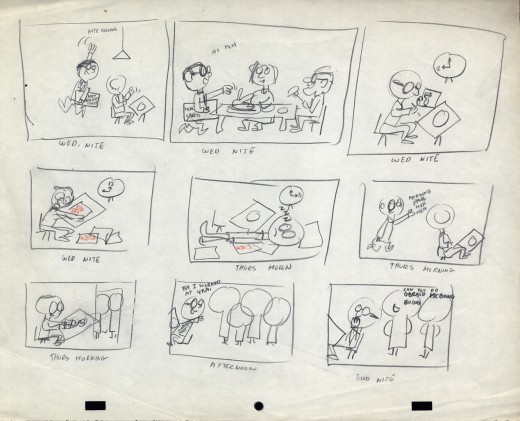 1
1
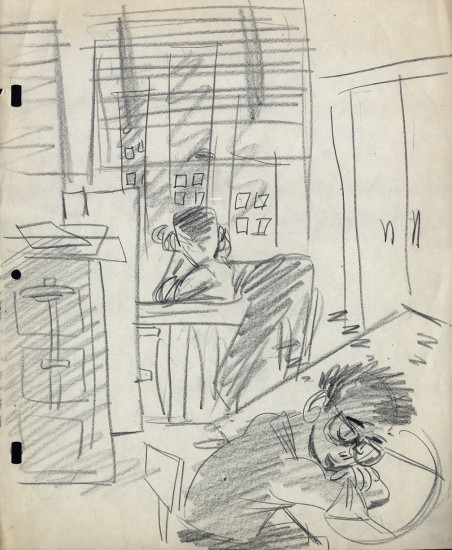 2
2
At UPA – NY, Lu Guarnier was the only animator
who had a window. Vince Cafarelli and Pablo Ferro
were Lu’s Assistants/Inbetweeners, so they also
had the luxury of a window.
- OK, now onto Robert Lawrence. The more I look into this company’s work the more impressed I am. The quality of designers and animators on board was extraordinarily high. I have a lot of Layouts for films that are completely lost. I’m not sure what most of the images are for or what the stories of the spots was. I just have drawings, and most of them are impressive, even more so in some ways than much of the UPA work I’ve seen.
So let’s take a look.
First there is the promo art. As an introduction to the company, here are four self-promo pieces that were used as trade ads for the company.
I’ve assumed that these images were created for a print ad in some magazine or another. There are three of them; one comes in a 2-color version.
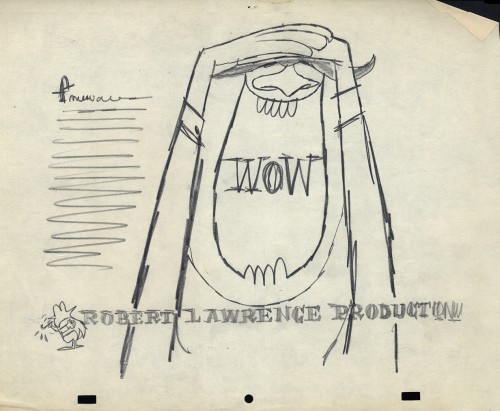 1
____________________________
1
____________________________Now we get into some of the fun stuff. Here are the layouts done in a million styles, all beautifully drawn and designed. I feel like I want to say thank you to some of the artists involved. If only I knew who the artists were. The drawings and cels were all done on paper with a “Signal Corps” hole-punch. (Looks like Oxberry, but the center hole is the same diameter thickness as the square pegs.)
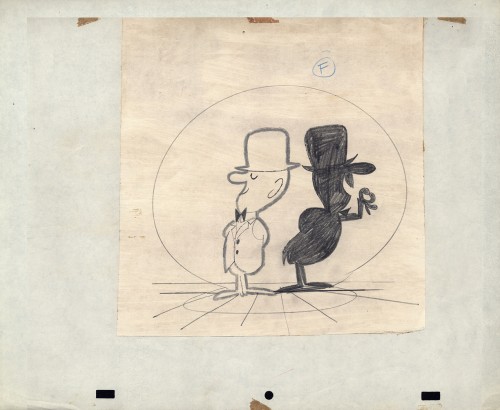 1
1This is a beautiful gag told a million times,
but done perfectly in this drawing.
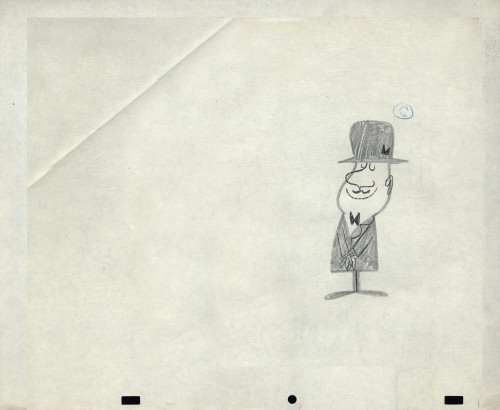 3
3
The inked arms in #1 are the variant. (Possibly a correction?)
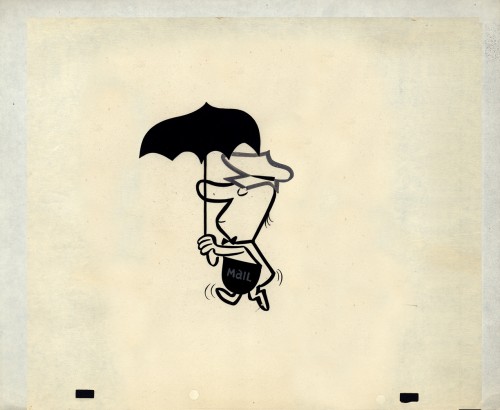 4
4
A cel not opaqued but beautifully inked.
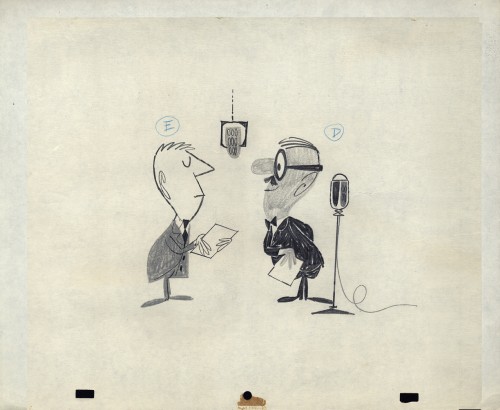 5
5
Obviously #5, 6, & 7 are the same characters in development.
It looks like #5 is probably the finished model.
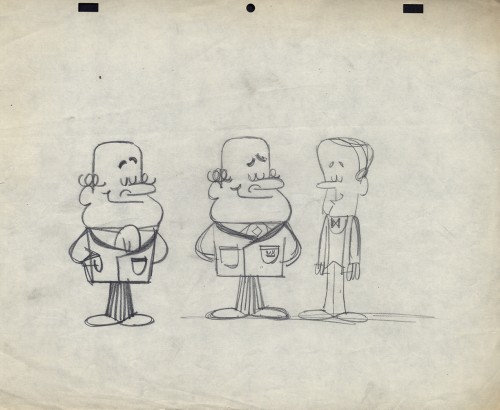 10
10
This looks a bit like Howard Beckerman’s style, but I’d
probably bet against that. The characters aren’t cute enough
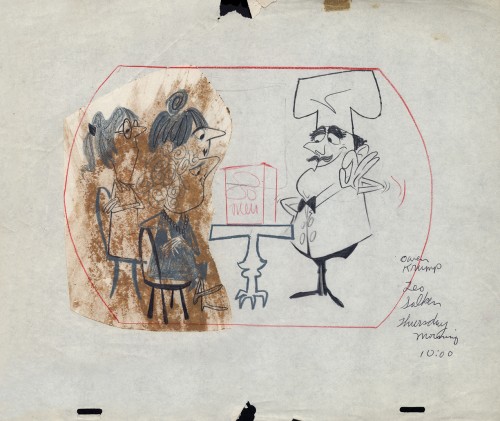 12
12
There’s a whole series of chef models
Then there’s a series of Cowboys.
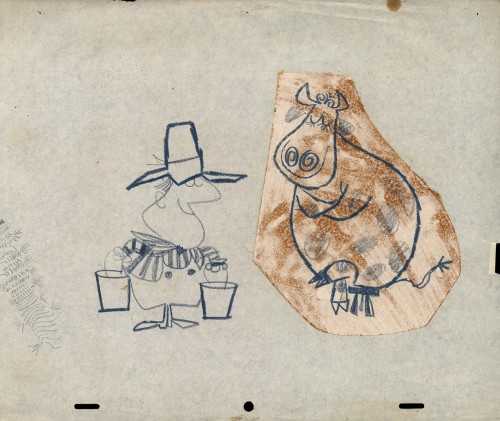 24
24
Then there’s the farmer milking the cow. Casting problems.
Animation Artifacts &commercial animation &Layout & Design &UPA 25 Jul 2012 05:21 am
Even More UPA Spots
- Here are more Layouts and character poses for the commercial work done at UPA. They are all pulled from Vince Cafarelli‘s collection of artwork. I assume these all come from UPA since Magoo models were in the same folder. The design styles are consistent with what we’ve seen from UPA at the time.
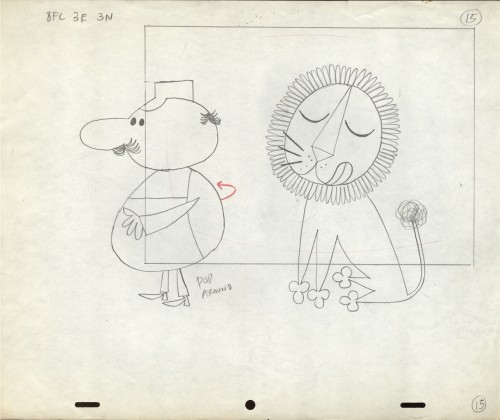 1
1
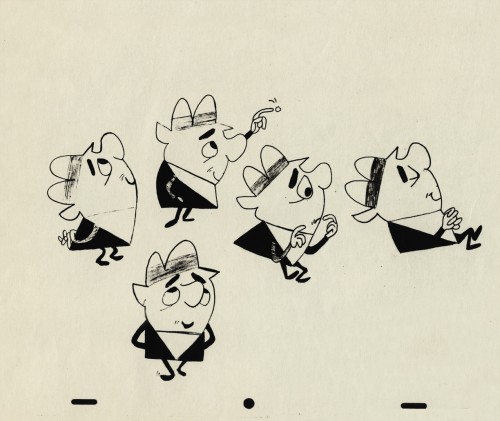 3
3
A photostat of a character model sheet
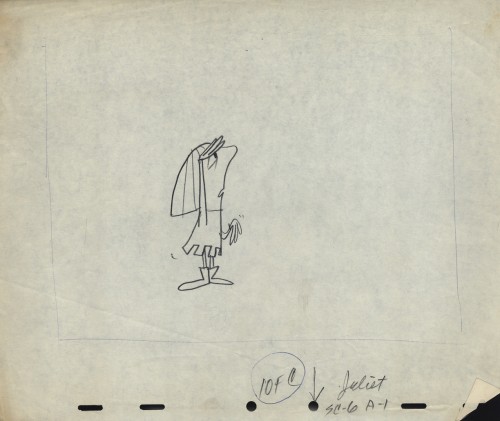 4
4
An ad that features Romeo and . . .
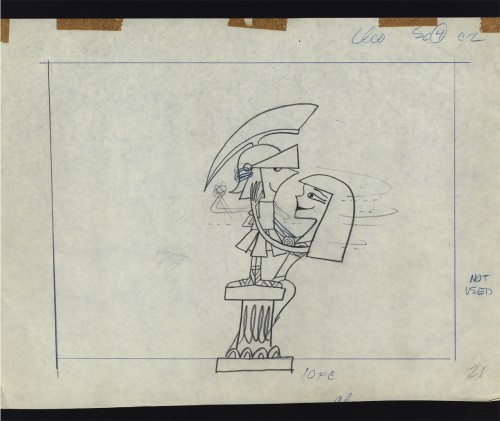 6
6
Cleopatra was obviously cut out of the spot.
Note that the pegs were cut off the NG drawing.
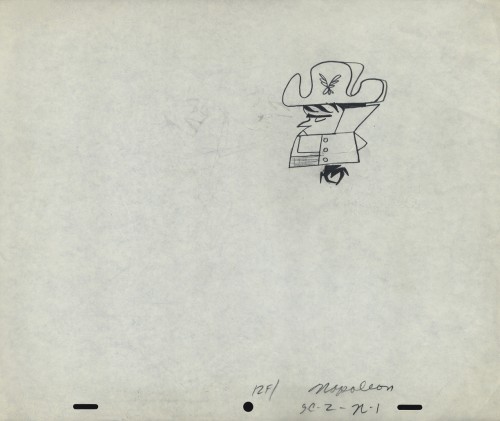 7
7
Napoleon, but it looks like it comes from a different spot.
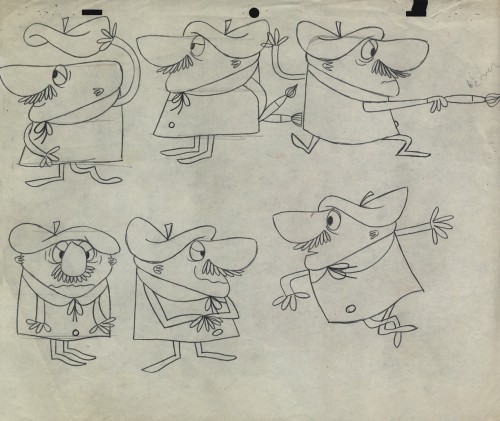 8
8
Was this something that stuck in Gene Deitch’s mind before he left
UPA to go on to run Terrytoons? Shades of Gaston le Crayon.
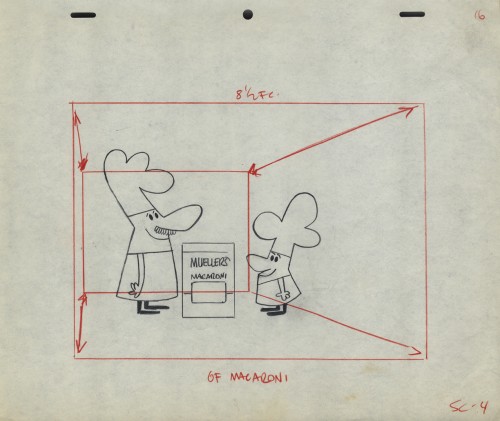 11
11
Obviously, an ad for Mueller pasta
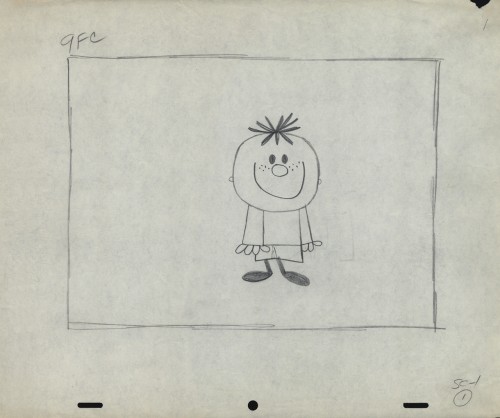 12
12
An interesting series of Layouts. I’m not sure if they’re for an ad . . .
Animation &Animation Artifacts &commercial animation &Layout & Design &Models &UPA 18 Jul 2012 07:05 am
More UPA Spots
- Out of the Vincent Cafarelli collection, we’ve found another burst of UPA drawings. We know they’re UPA because there are models and animation drawings from a Mr. magoo short: “People to People.” The accompanying drawings from commercial spots and segments of the Gerald McBoing Boing Show all come on the same paper stock. The peg system is Acme not Signal Corps (which leads me to believe that some of those I called UPA in a past post are really from the Gifford Studio.)
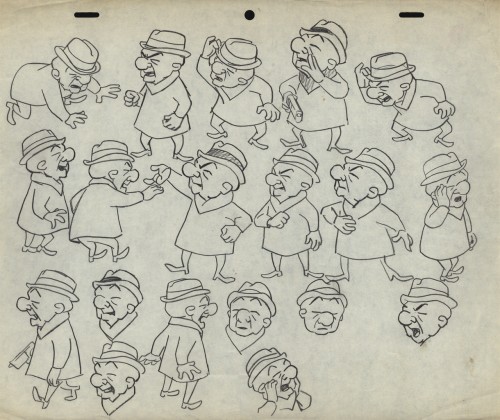 1
1This model and the other Magoo pieces here are from
the short “People to People” which features a gorilla.
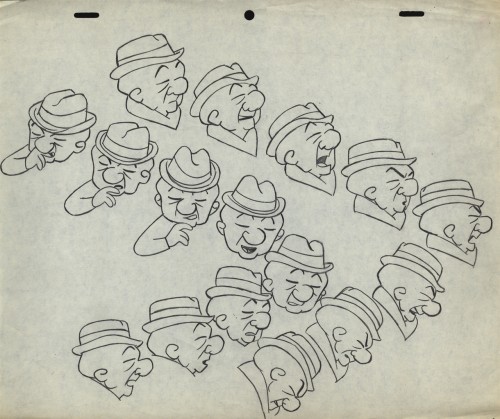 2
2
Per Mark Mayerson, in the comments section, the film was retitled
Terror Faces Magoo and was directed by Chris Ishii and Jack Goodford.
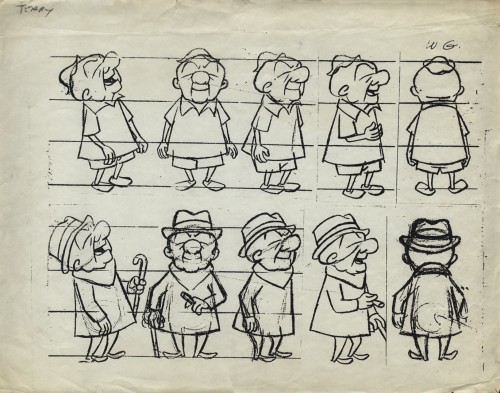 3
3
See the film here.
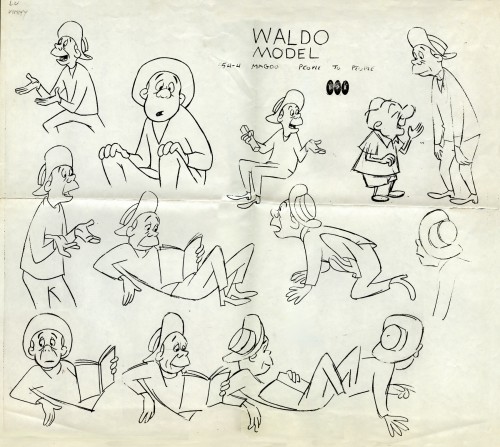 5
5
This model comes with the names “Lu” and “Vinny” indicated.
Obviously Vinny Cafarelli was Lu Guarnier’s assistant.
The following three drawings are key animation poses of the Gorilla.
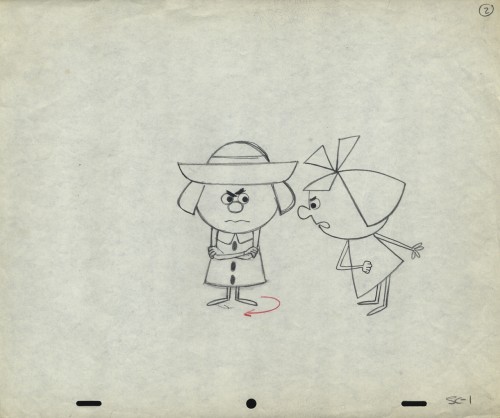 16
16
This is obviously a drawing of the Tworlinger Twins, a
series done for the McBoing Boing show. The NY office
seems to have done a number of pieces for the show.
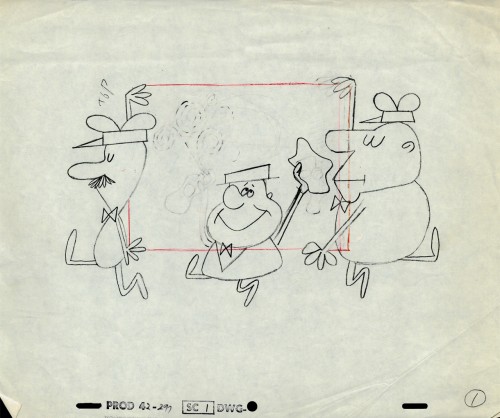 17
17
These guys look similar to the three who open
the McBoing Boing Show carrying their logo.
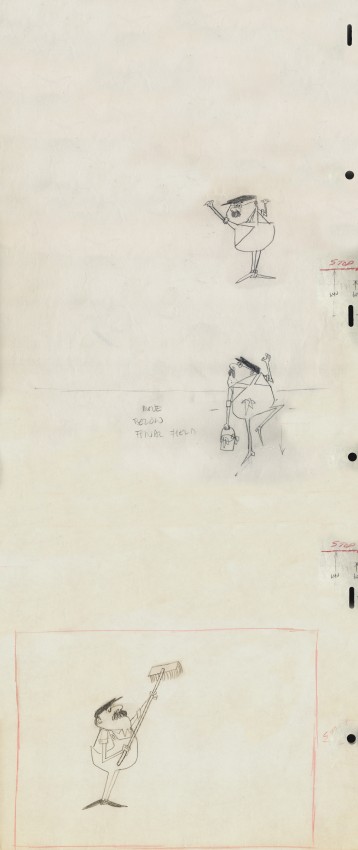 18
18
A vertical pan for a Savarin Coffee spot. A sign painter
pastes a placard of the product on a billboard.
Animation &commercial animation &Layout & Design &UPA 27 Jun 2012 05:44 am
UPA Commercial Layouts
- Having swept through Vince Cafarelli‘s collection of Fleischer/Paramount artwork, We move onto the next box which is his commercial work. Vince was an Assistant Animator at UPA New York. He saved a group of layout drawings for some of the commercials. Unfortunately, only a few are marked as to what the sponsor was. so it amounts to a number of drawings which often have no relation to each other.
However, the drawings included all are good representation of the beautiful and diverse design employed at the studio. Here are a first group; when I can identify the spot, I will. If you recognize any of them, please let me know.
The peg system used throughout is called “Signal Corps.” This is where the size of pegs was first used. By this time, New York animators had three different sized pegs to use: Acme, imported from California;
Signal Corps, a hold-over from the Army, and
Oxberry, invented just after the War by John Oxberry.
They all had their different advantages, and they all remained in use through the 80s, when Acme finally took over.
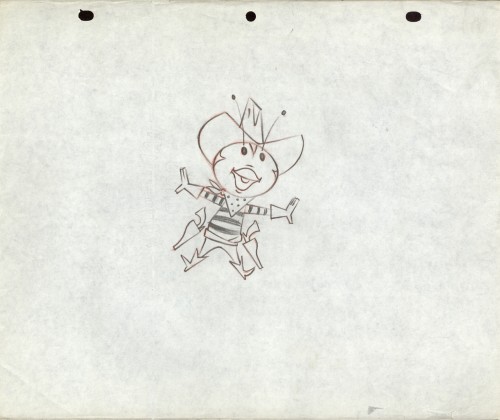 1
1Mark Kausler commented: “… the first two are “Buffalo Bee†from
the Nabisco Wheat Honeys commercials. Mae Questel was the voice,
they appeared on the early Mickey Mouse Club shows, 1955-56.”
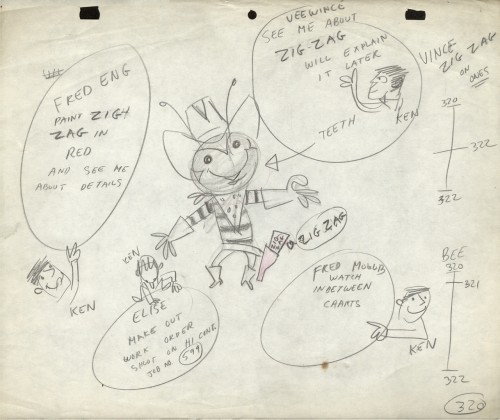 2
2
Note how the animator leaves notes for the crew who will work on the spot.
“Vince” was the Assistant Animator. “Fred Mogubgub” was the inbetweener.
“Elise” was the checker/Prod. Coordinator, and “Fred Eng” the talented inker.
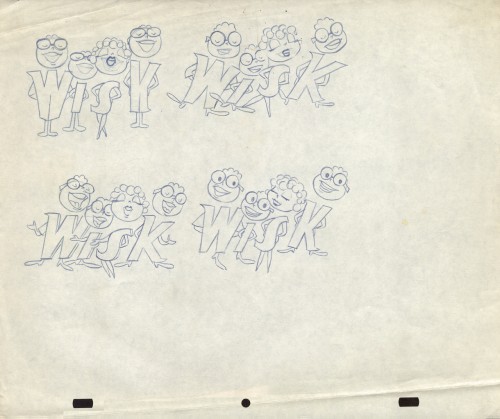 7
7
This is obviously for a Wisk commercial.
The final six LO drawings are Emily Tipp for Tip Top bread.
She was a very successful spokesperson for the bread company.
These may have been done at Kim-Gifford Studios rather than UPA.
I kept them with UPA because the peg system is consistent
with other UPA commercials.
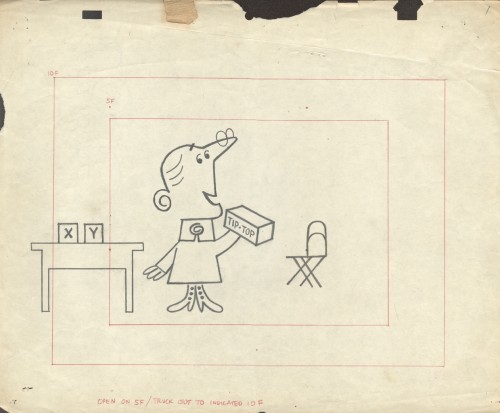 10
10
To see some of the Emily Tipp spots go here
at the Buzzco website.
Frame Grabs &Hubley &UPA 18 Jun 2012 06:40 am
The Four Poster – part 4
- This is the fourth part of the animated segments from the live feature, The Four Poster, with animated segments from UPA directed by John Hubley with animation directed by Art Babbitt and design supervised by Paul Julian.
As I wrote with each of the past posts, the film is an adaptation of the play by Jan de Hartog which takes place wholly in one room – the bedroom – around a fourposter bed. We see scenes wherein the couple marries young and grows old together. The only time we stray from the room, in the film, we do it via the enormously creative UPA animation. The film starred real husband and wife, Rex Harrison and Lilli Palmer.
This sequence represents an attempt for the couple to come together again after a difficult period. They take a vacation to Paris, France.
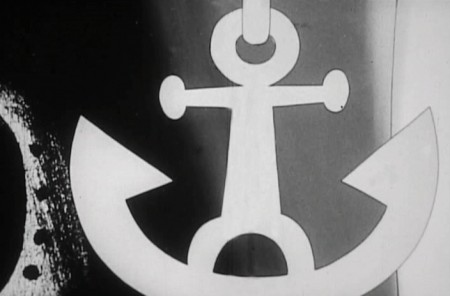 1
1Cut to an anchor being lifted.
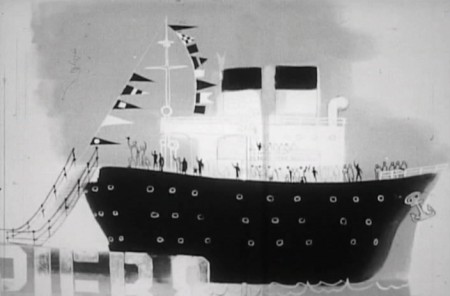 2
2
The cruise ship is set to take off.
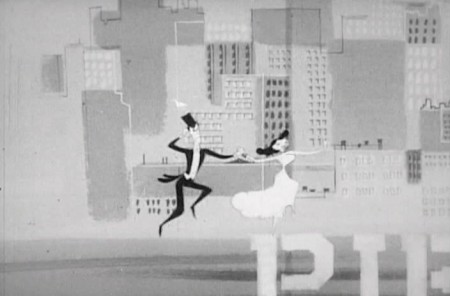 3
3
Our couple races to the ship, they’re late.
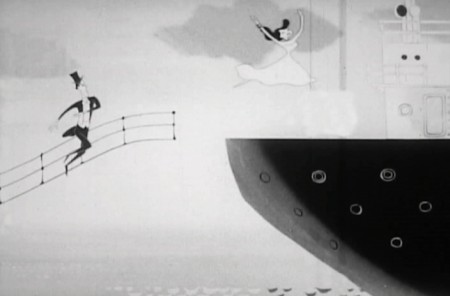 5
5
As the ship pulls away she jumps on board.
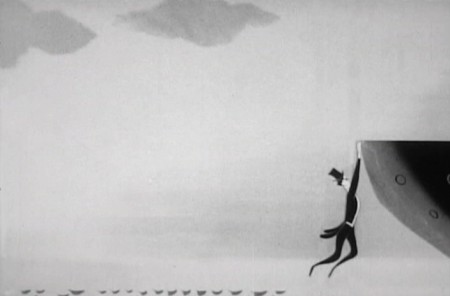 6
6
He tries and misses, hanging at the edge.
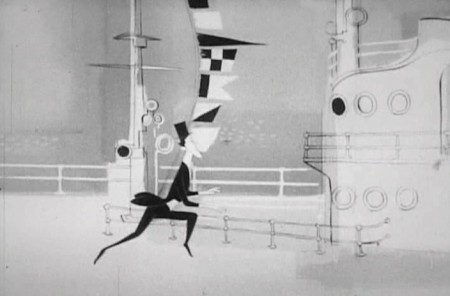 7
7
He lifts himself on board . . .

. . . but has to search for his wife.
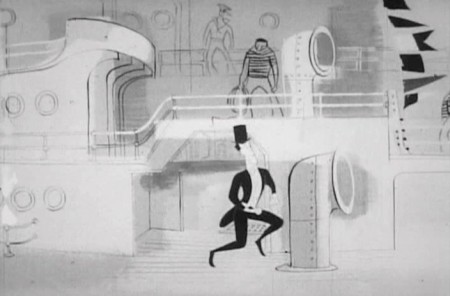 11
11
He continues to dance in search of his wife.
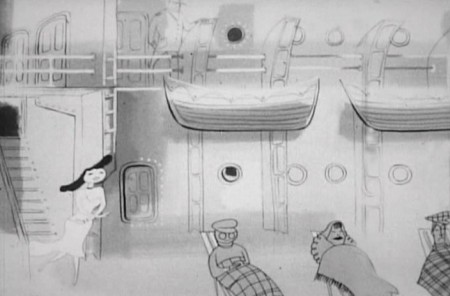 12
12
She’s just a bit forward of him.
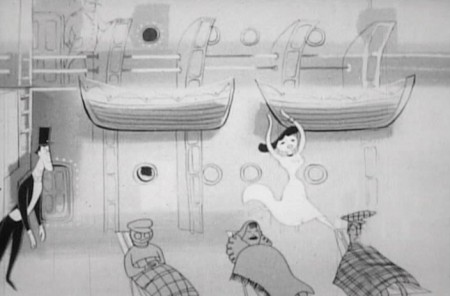 13
13
She dances over some resting passengers.
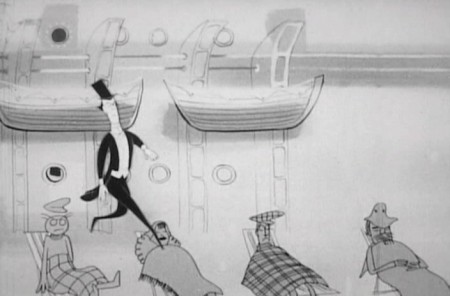 14
14
He tries to do the same, but ends up . . .
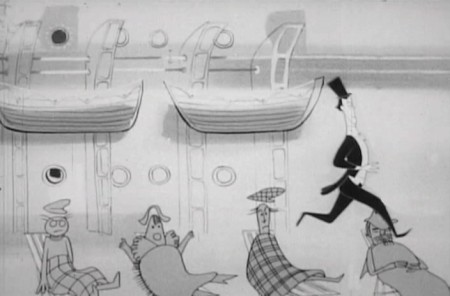 15
15
. . . stepping on each of the people in deck chairs.
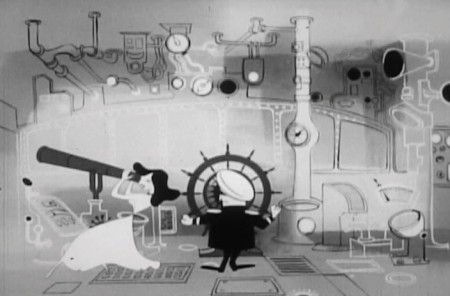 16
16
She’s in the captain’s chair looking through a telescope.
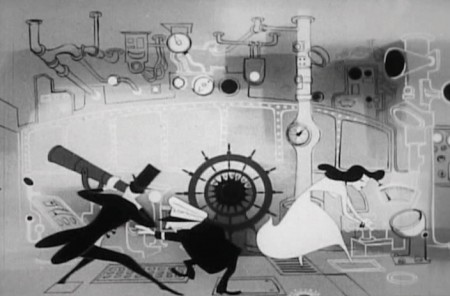 17
17
He joins her to see what she’s been looking at.
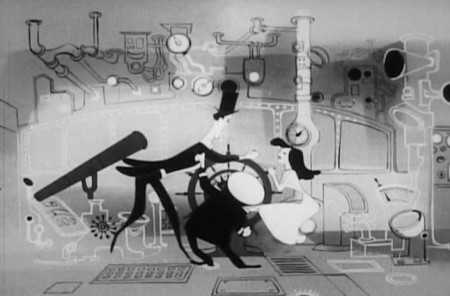 18
18
The two of them scrabble over the steering wheel.
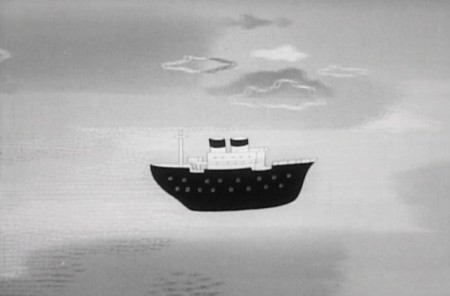 19
19
The ship spins about at sea.
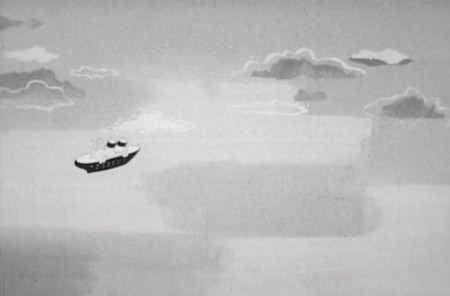 21
21
It goes spinning into the horizon.
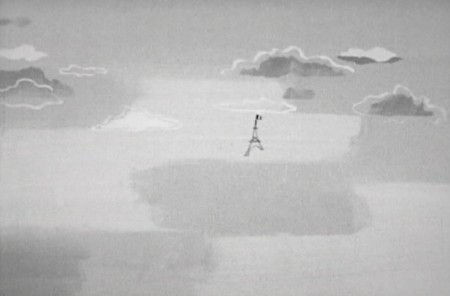 22
22
The Eiffel Tower dances forward.
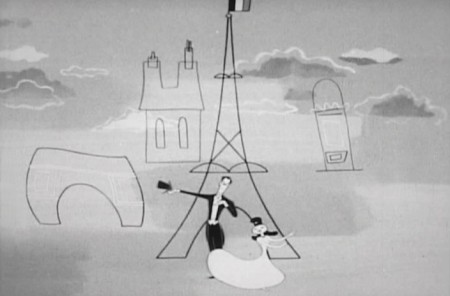 24
24
They finally join in front of the landmark.
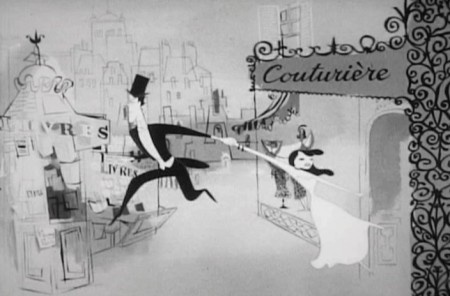 26
26
He tries to pull her away from a Couturier (dress maker).
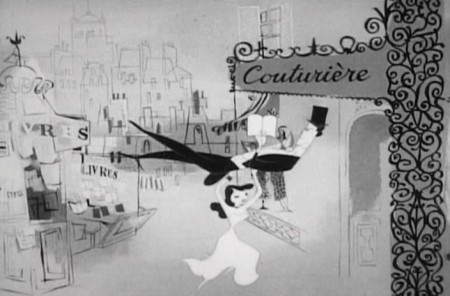 27
27
She ends up literally carrying him into it.
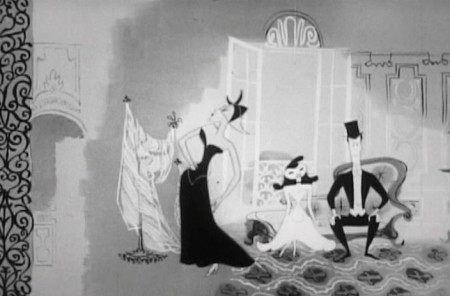 29
29
He’s seated on a devon to watch the fashion show.
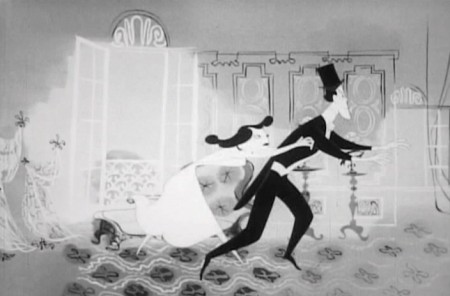 30
30
Finally, he pulls her further in . . .
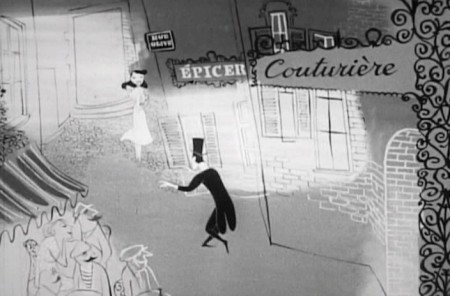 31
31
. . . and she leads him outside.
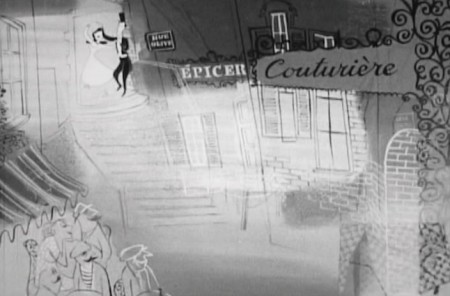 32
32
They pause at the top of a stairway.
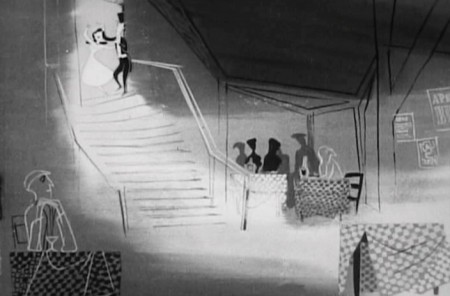 33
33
The background dissolves to a cabaret.
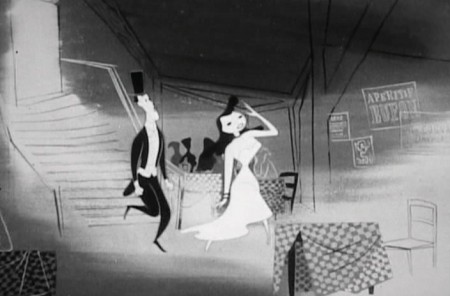 34
34
The couple enters and seats themselves at a table.
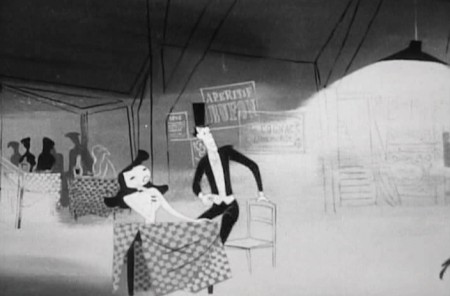 35
35
There’s no doubt that Art Babbitt animated this “Apache Dance.”
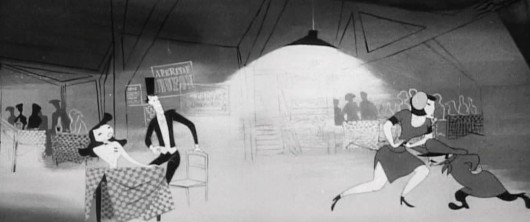
Pan across as an “Apache Dance” is in progress as the floor show.
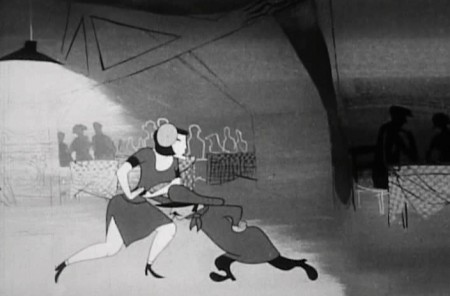 37
37
The male pushes the female back toward the couple’s table.
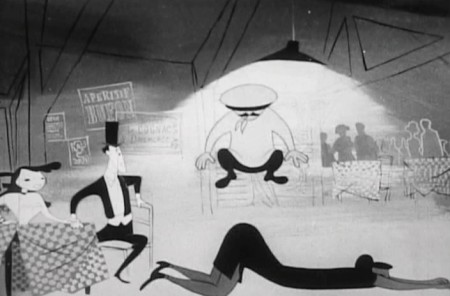 38
38
He jumps on top of her, in rhythm to the music.
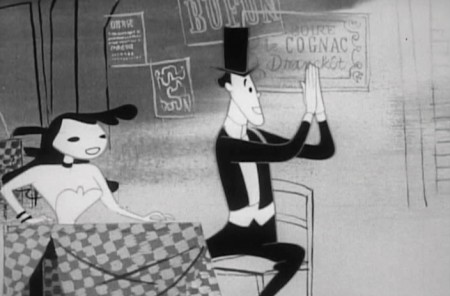 39
39
2 shot – He applauds the dance.
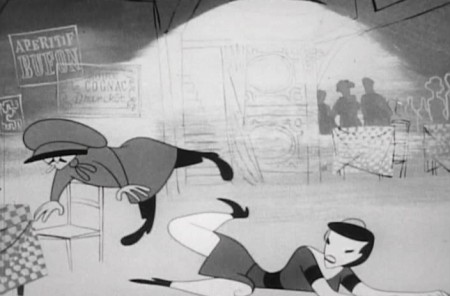 40
40
She knocks the male dancer off his feet.
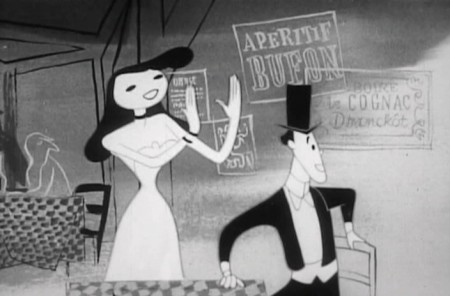 41
41
2 shot – she applauds the female.
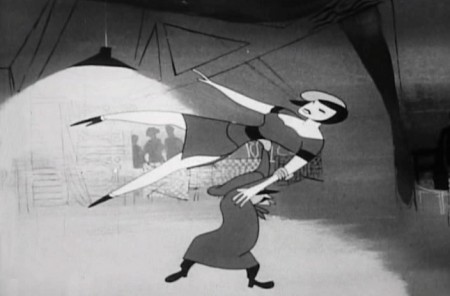 42
42
The guy lift the female over his head
and off the screen.
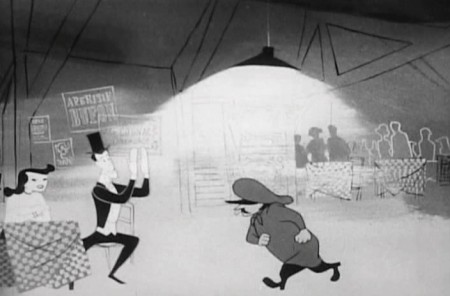 43
43
He then goes to our male and . . .
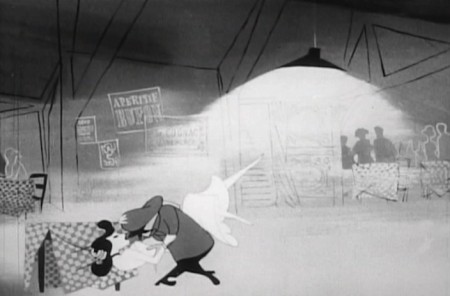 45
45
The male then dances with her.
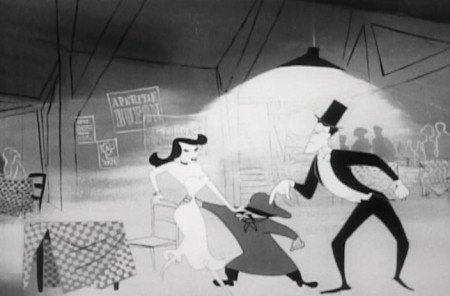 46
46
Our hero enters, and taps the dancer on the shoulder,
as if it’s his turn to cut in to the dance.
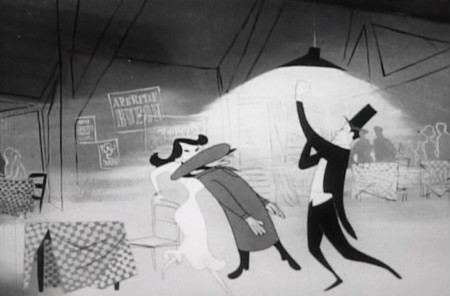 47
47
Instead, he knocks out the male dancer.
All to the rhythm of the song.
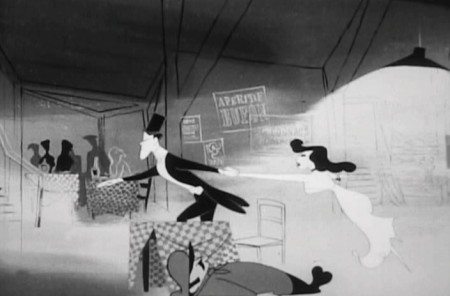 48
48
Our couple dances toward the door.
Exit Paris.

. . . and the camera pans back . . .
The final sequence begins with the couple elderly and close.
It becomes obvious that she dies as we move to him writing at his desk.
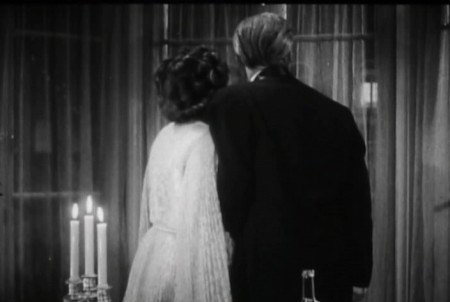 1
1
We see a beautiful Paul Julian painted sequence which shows
their house as it grows old in a series of dissolves.
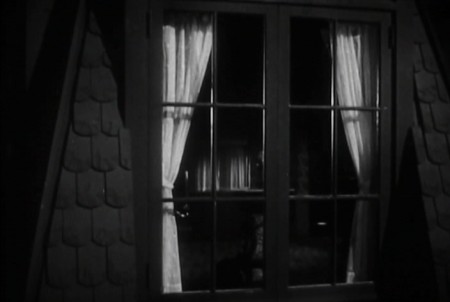 12
12
Back in through the Live Action window.
We see him with his head at rest on his desk.
It seems obvious to me, after all the time I’ve recently spent studying the UPA Å“uvre, that there were a lot of forward thinking individuals who were quite adept at creating modern designs, quite like new textiles or illustrations. However, it would seem to me that only a small few were actually artists. John Hubley and Paul Julian were certainly in this latter character. Hubley was incapable of drawing a cartoon, and Julian was painting his backgrounds in the same, serious style as his own Art. Together, they were brilliant. It’s only unfortunate that they didn’t have the assist of animation by Bobe Cannon. He is one who took the animator’s job to a higher order. We’d have to wait a decade to see Hubley and Cannon together, but, by then, Julian wasn’t available to them, and Hubley painted his own Backgrounds. See Adventures of an * or Tender Game, and try to see one of the stunning, newly reconstructed prints from MoMA.
Frame Grabs &Hubley &UPA 11 Jun 2012 07:01 am
The Four Poster – part 3
- I’ve located a better copy of The Four Poster, so my posts will be more in focus henceforth. I’ve gone back and replaced the images in Part 1 and will do the same for Part 2 in the next week.
The Four Poster, in case I have to remind you, is a live action feature adaptation of a play by Jan de Hartog. It was produced by Stanley Kramer and directed by Irving Reis. The film takes place entirely within the bedroom of a married couple as they grow old together. To open up the film, they turned to animation working with the Columbia studio, UPA. John Hubley supervised all of the animation following his recently completed film, Rooty Toot Toot.
Part 3 starts as the couple’s child has grown up and gone off to War. World War I. The sequence was supervised by Paul Julian, and like most of his other directorial efforts it’s about beautiful paintings and graphic movement.
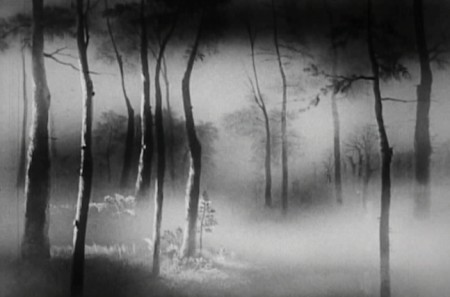 1
1
_______________________________
From the death of their son, the film takes us forward into the Roaring Twenties.
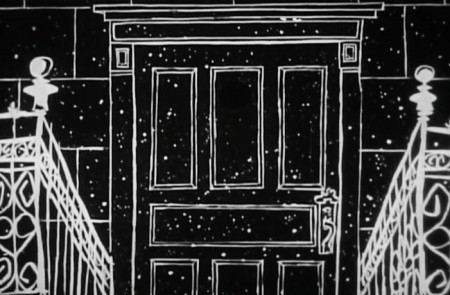 1
1
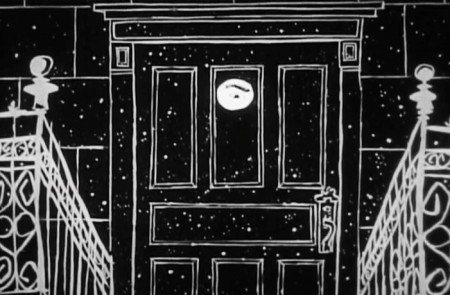 2
2
It’s a world of speakeasies.
Frame Grabs &Hubley &UPA 04 Jun 2012 06:54 am
The Four Poster – part 2
I’ve recently purchased what, I think, is a much better copy of this film. When it arrives, I’ll replace this and the last post with better images and continue on from there. In the meantime, I’ve done this post.
- Last week we bit into the UPA animated sequences from The Four Poster. These were directed by John Hubley, with Paul Julian credited as designer and Art Babbitt and Lew Keller credited as animators. Of course, more people were involved in that they broke the film up into segments with different teams doing individual segments.
The animation, naturally is in B&W (to match the live action film they were designed to interecede.) The boring live action film is an unimaginative adaptation of the Broadway play by Jan de Hartog. It became a travelling show that was often performed by husband and wife teams. In fact this film stars a husband and wife: Rex Harrison and Lilli Palmer. It was produced by Stanley Kramer and directed by Irving Reis. Kramer, who was very political in his film making (High Noon, Guess Who’s Coming to Dinner, Judgement at Nuremberg) no doubt stayed away from the set rather than deal with the volatile actors on the set. He had an easier time of it hiring the animation studio; he just stayed on the Columbia lot.
The film never strays from the bedroom of this couple, and we get the life story of the couple from the vantage point of the bedroom, which features the titular fourposter bed. Quite claustrophobic. They expand on it using the animation, and one almost wishes they had done the entire film in animation. It was later adapted into a musical called, I DO, I DO, and starred Robert Preston and Mary Martin on Broadway. It was written by Tom Jones and Harvey Schmidt (who also wrote THE FANTASTICKS.) That’s a much better show; the songs make it tolerable.
Here are frame grabs from the next two sequences: 3 & 4.
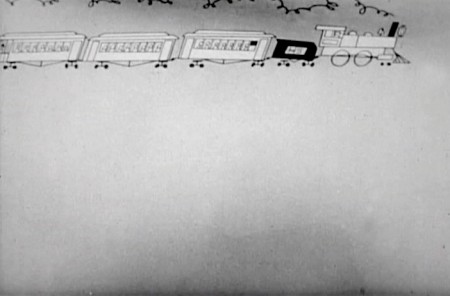 1
1A train enters and the camera moves in on it.

A pan (right to left) shows a lot of women reading
books by our lead character John Edwards (Rex Harrison).
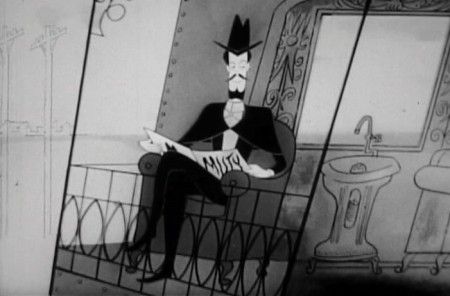 4
4
The pan ends on Edwards seeing
the full car of women staring at him.
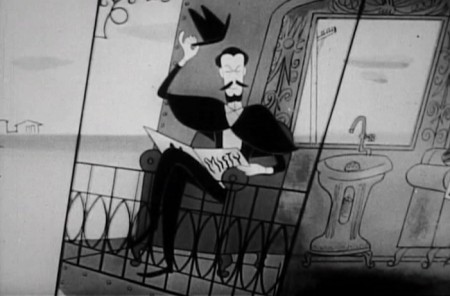 6
6
He acknowledges them as . . .
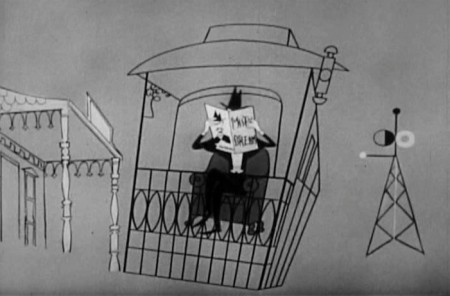 7a
7a
. . . the train moves on, and . . .
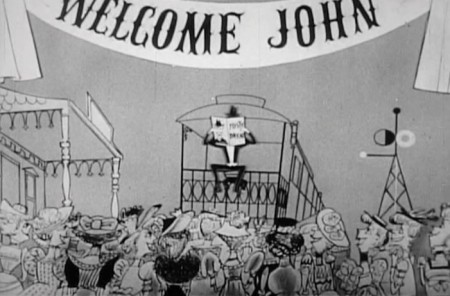 7b
7b
. . .there’s a slow transition . . .
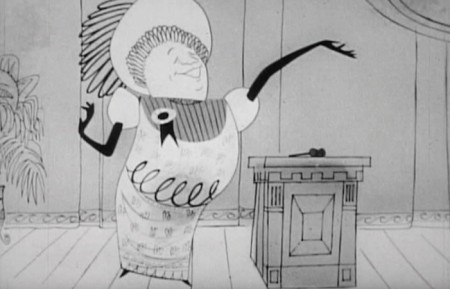 10
10
A woman speaker introduces him.
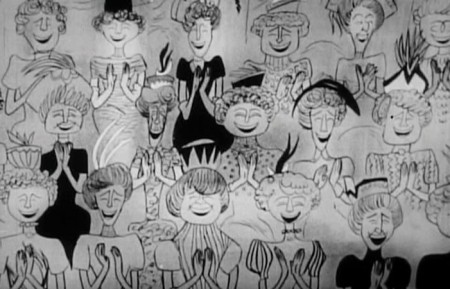 11
11
The female audience applauds enthusiastically.
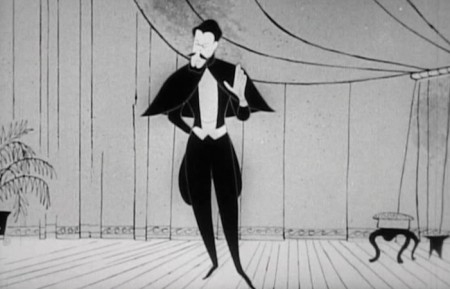 12
12
He stands to speak and . . .
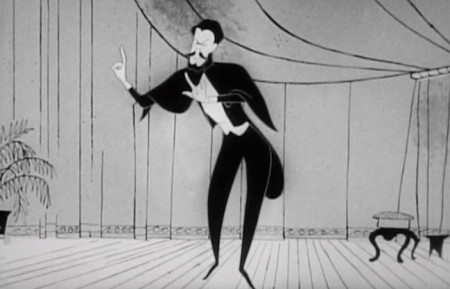 13
13
. . . gives his speech in mime. We don’t hear his words.
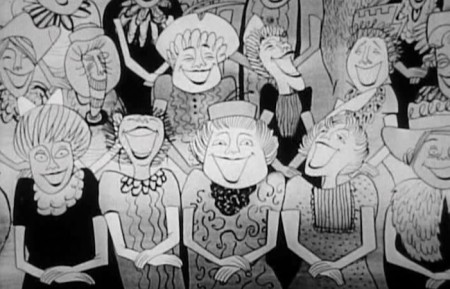 14
14
The woman laugh enthusiastically at his joke.
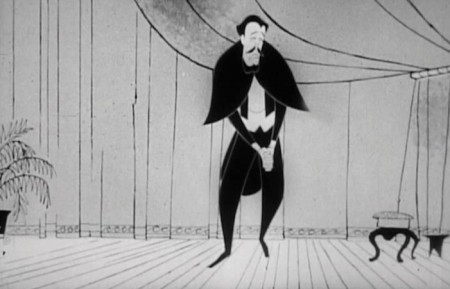 16
16
I can only wonder whether this had any influence
on Hubley’s later film, Zuckerkandl.
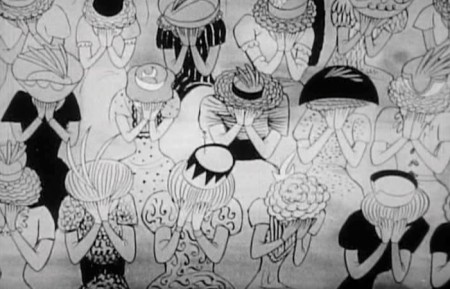 18
18
The women are in hands. They’re crying.
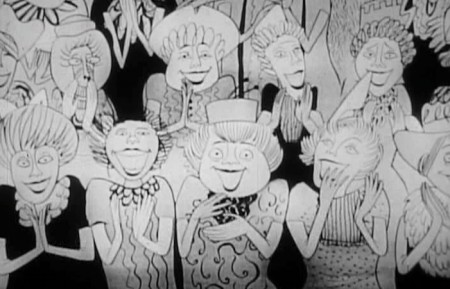 22
22
They audience is overwhelmed.
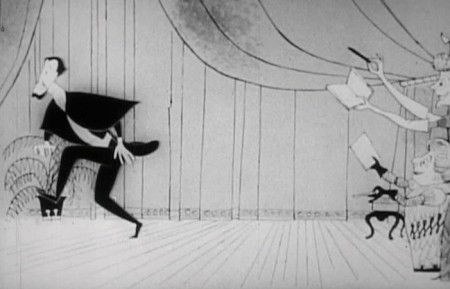 24
24
He’s chased from the stage.
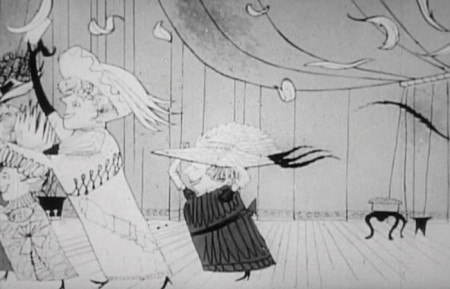 26
26
They rush him leaving feathers flying from their hats.
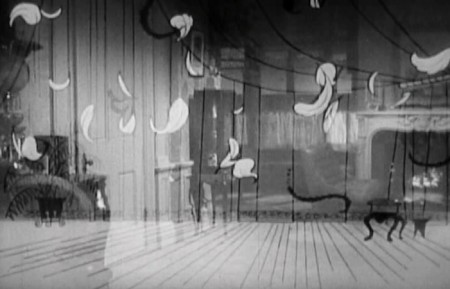 27
27
There’s a transition back to the live action bedroom.
.
__________________________
The fourth section is designed only to show us that time has passed and the city is growing up around their ears. They remain in the same house the went to after first getting married (obviously, or the film’s title would be pointless.)
.
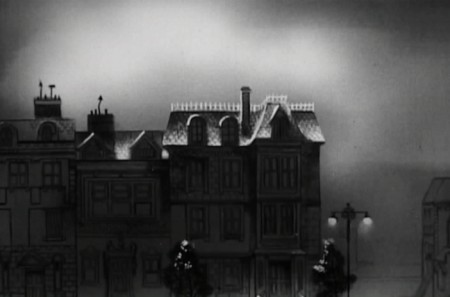 1
1

As we pan from left to right, the city builds up for the camera.
The bridge, on the far right, is the last structure to be constructed.
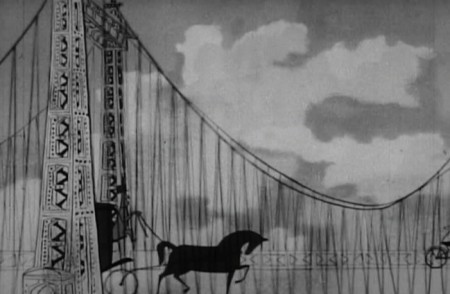 8
8
Cut in to the bridge as a horse drawn carriage enters . . .
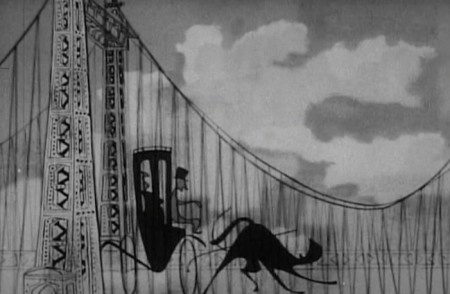 9
9
. . . and before our eyes , , ,
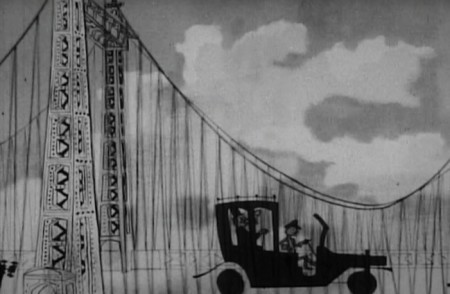 10
10
. . . turns into an automobile.
Animation Artifacts &Frame Grabs &Hubley &UPA 28 May 2012 06:21 am
The Four Poster
- One of the real neglects in animation history is the availability of The Four Poster in VHS, DVD or any other format. For some reason, this title has eluded marketers who’d want to cash in on the name of Rex Harrison or his wife, Lilli Palmer. Where’s TCM when you need them.
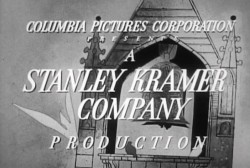 This film was a Stanley Kramer production directed by Irving Reis in 1952 of a play by Jan de Hartog. It tells the life story of a marriage between the husband and his wife. In fact, the film is so insular that it never leaves the bedroom, and it revolves around the “four poster” bed in that room. For the film, they chose to open it up by leaving the bedroom via animated inserts done by John Hubley at UPA. There are some 20 minutes of the film done by Hubley/UPA, and it’s extraordinarily progressive animation for the time.
This film was a Stanley Kramer production directed by Irving Reis in 1952 of a play by Jan de Hartog. It tells the life story of a marriage between the husband and his wife. In fact, the film is so insular that it never leaves the bedroom, and it revolves around the “four poster” bed in that room. For the film, they chose to open it up by leaving the bedroom via animated inserts done by John Hubley at UPA. There are some 20 minutes of the film done by Hubley/UPA, and it’s extraordinarily progressive animation for the time.
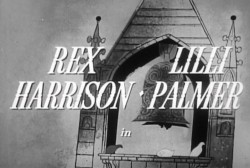 I own a good 16mm copy of the whole film, and cut the animation segments separate from the feature, I allowed a friend to make a video copy but was very disappointed with the results – out of focus and almost unwatchable. In the past couple of weeks, another friend led me to a second DVD copy which is also out of focus but not as bad as the first.
I own a good 16mm copy of the whole film, and cut the animation segments separate from the feature, I allowed a friend to make a video copy but was very disappointed with the results – out of focus and almost unwatchable. In the past couple of weeks, another friend led me to a second DVD copy which is also out of focus but not as bad as the first.
I’ve wanted to focus on this film for some time, hence I decided not to wait any longer and am sharing frame grabs with you of this muddy, soft focus version. You can still get the idea. If another, better copy turns up in the future, I’ll rework these images and repost it.
Here are bits from the opening credits. Lots of traveling right and then left and then right again.
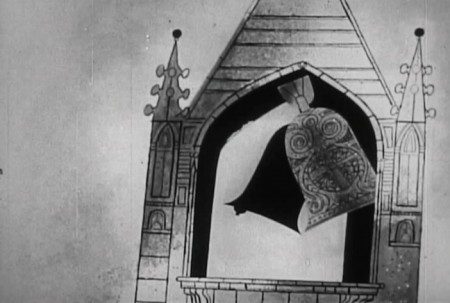 3
3The film does get very claustrophobic staying in the one bedroom set
for the entire film, with just the two characters, husband & wife, to talk
us through most of the movie. It’s exhausting.
This makes the animation more welcome than it would ordinarily be.
You’re dying for any excuse to change scenery and move the story forward.
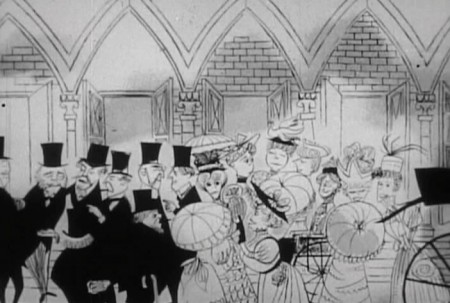 4
4
On top of this, the live action is very theatrical
whereas the animation is full of life and quite lyrical.
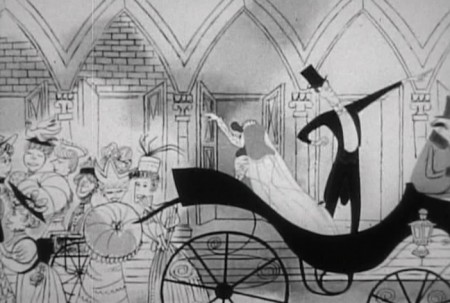 5
5
The animation does reveal a good part of the story from the
birth of their boy to his death in WWI on the front lines.
(Hubley designs one of his greatest sequences for this one.)
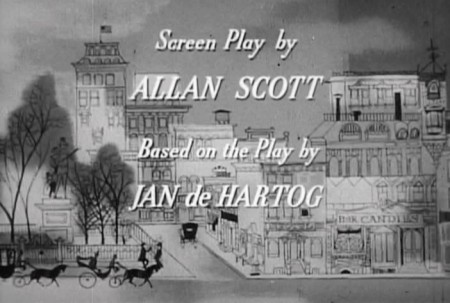 8
8
Supposedly, the film was sent to Yugoslavia for a run.
Some of the people in Zagreb were able to kidnap the film
and hold onto it for a number of additional weeks. They
studied it closely and copied it.
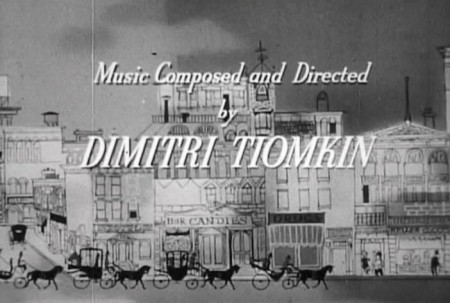 9
9
When they were finished the print was returned to
the States, and they started up Zagreb animation with their
new-found knowledge and inspiration. A bit more than inspired,
shall we say. How very 21st Century of them
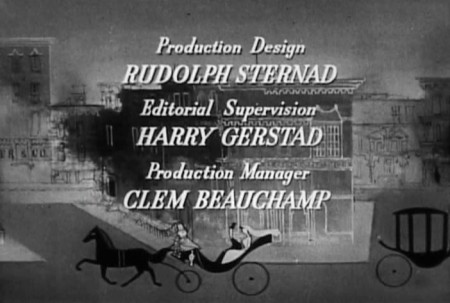 12
12
In his book, When Magoo Flew, Adam Abraham doesn’t give a lot of
space to the work on this feature. However, every small comment
seems valuable since so little has been written about this film.
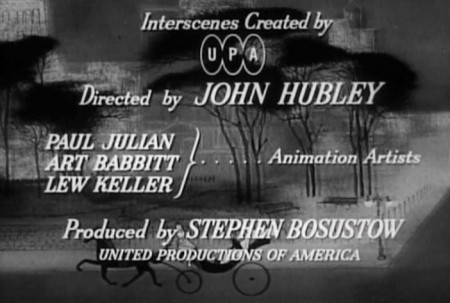 13
13
Abraham says that Hubley and crew went onto this directly after
finishing Rooty Toot Toot. They were broken into small groups
with each group doing one of the interecenes in the feature.
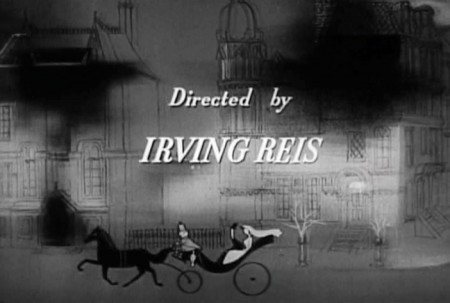 15
15
Paul Julian oversaw the stylistic representation of the War
and Art Babbitt animated the sequence showing the effect
of the war on the soldiers coming home.
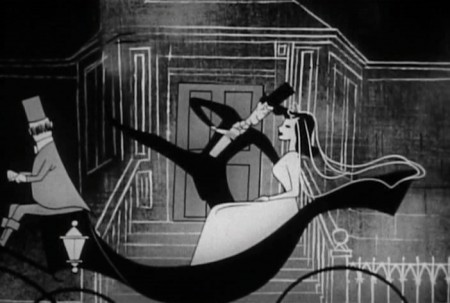 16
16
In total, it’s an enormous accomplishment.
____________________
.
The first animated intersection shows the Rex Harrison character going off to work as a teacher in a boys’ school.
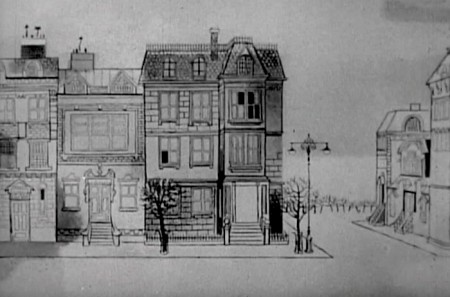 1
1
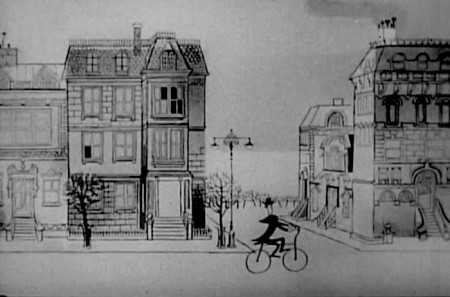 2
2
Out of the home, Rex Harrison’s character
comes cycling on his way . . .

. . . to school. Like many other sequences in this animation,
he rides a long pan to the school where he enters on bike.

Inside the school, we echo the first scene with another pan.
This time we pan from class to class ending with . . .
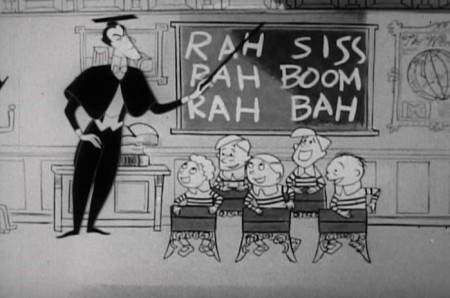 5
5
. . . Rex Harrison’s very unethical class, where the kids are having fun.
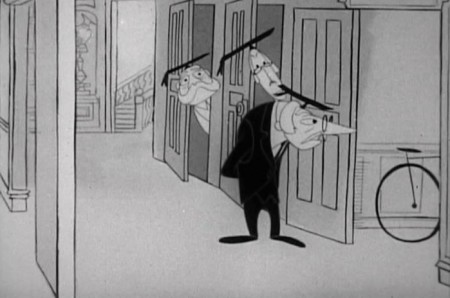 8
8
The raucus noise of his class is disturbing other teachers.
They don’t like the students having fun.
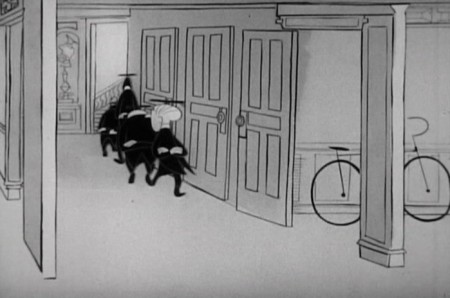 11
11
Off to the Dean’s office to complain.
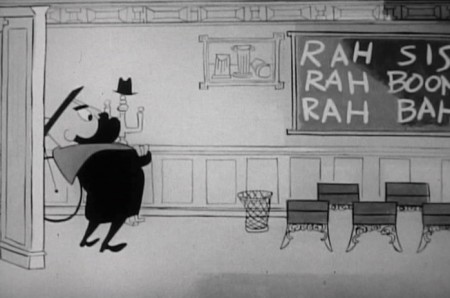 16
16
The Dean breaks in to something too much fun.
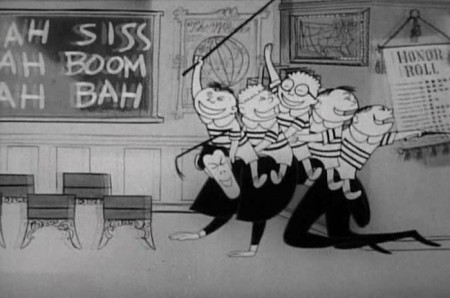 17
17
Even with the soft focus, you can see
that the character design is great.
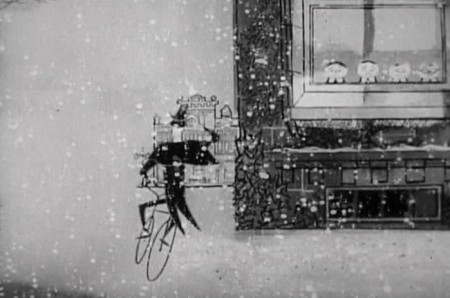 20
20
He goes off into the sunset of a
snow fall.
Back to live action
